Revelations on Revelation (Part V)
As I mentioned at the end of Part IV, the Left Behind film trilogy doesn’t actually get too far into the tribulation timeline or even talk much about what’s coming down the pipe. But in comparison, the four films of the A Thief in the Night series make it almost all the way to the Battle of Armageddon, which means they cover the majority of the content, although not the time period, depicted in the Book of Revelation:
End Times timeline

I should warn you that as a result of the much larger number of Bible-inspired plot points in the A Thief in the Night series, and the degree to which the series explores the (very relevant for viewers) question of who is able to be saved — and when — this post ended up considerably longer than the discussion of the tribulation in the Left Behind franchise in Part IV.
As a result I’m actually going to split the discussion yet again into two posts: the events of the first three films in Part V and the last film and further commentary in Part VI. I’m a little worried now that I’m just going to keep writing more than I expect and splitting these posts indefinitely in a cell division–type process and I’ll never actually get to the end of the series:
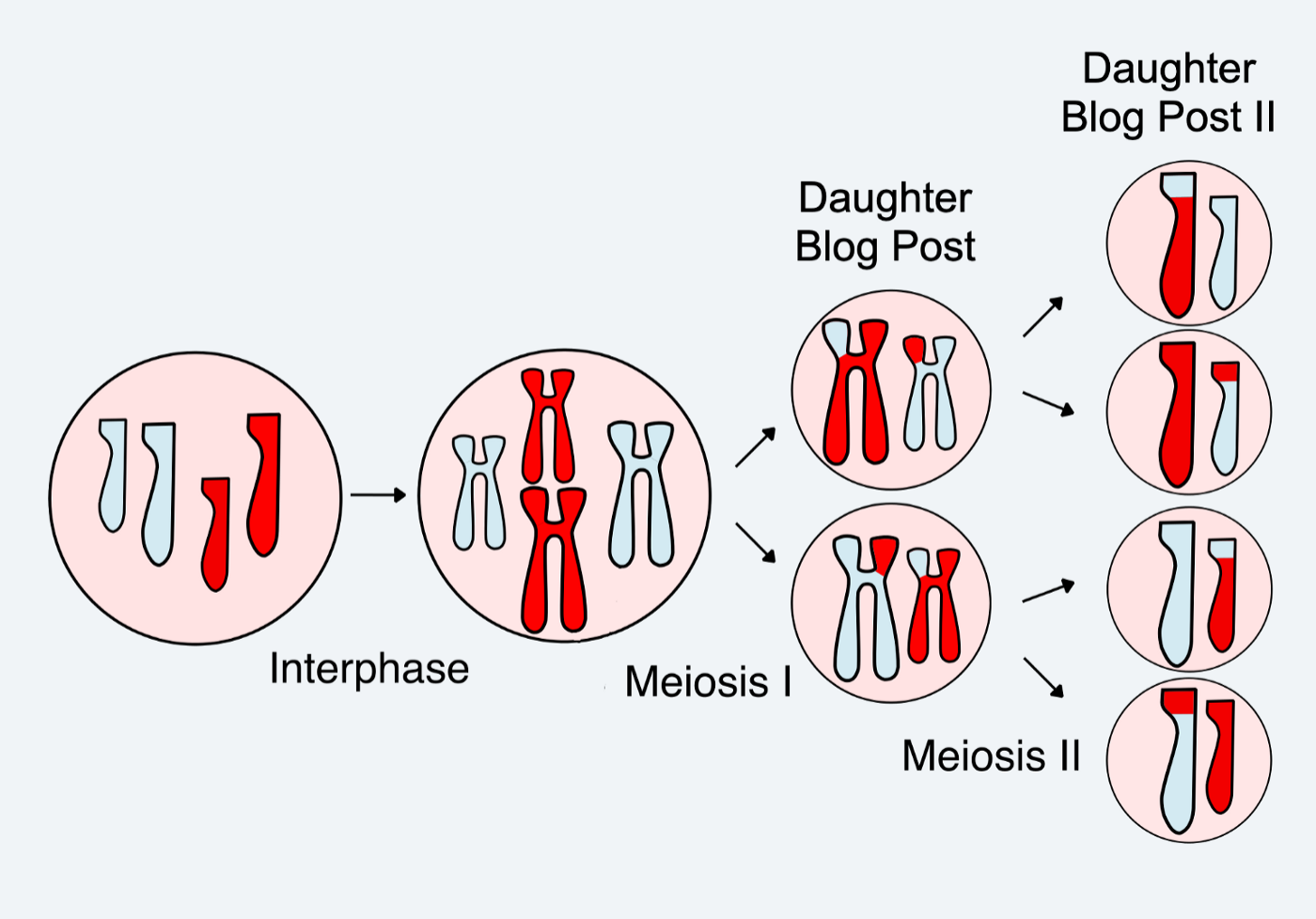
Anyway, as we get to them in this post, I’ll add separate diagrams for the seven seals, trumpets, and bowls (which are in Part VI), to make all the events during the tribulation that are portrayed in the films a little easier to follow.
But you can still rest assured that, like the Dragon, you too will eventually be freed at the end of Part VI for a brief look at “I Wish We’d All Been Ready” and some more fun facts about Larry Norman.
And then in Part VII you’ll be cast into some fire-heavy analysis of the signs that dispensationalists see as indicating that the End Times are coming soon, as well as the real-world consequences of seeing global events that way, but I am hoping I can halt the blog division and it won’t last forever.
Table of Contents
The tribulation in pop culture (continued)
A Thief in the Night
Before I get started, I have to drop one more warning: what’s depicted as happening after the rapture in this film has a complicated relationship with the events depicted in the rest of the series. But I’ll do my best to explain it at the end of this section, before I move on to the second film.
Picking up shortly after we left off in Part III, Patty sees a news report on TV where a spokesman says that the UN has set up a world government that will override national sovereignty for the duration of the “emergency.” It is called the United Nations Imperium of Total Emergency (UNITE). And, the spokesman says, it is made up of leaders from ten major world powers, which, like Nicolae’s ten super-powerful UN delegates in Left Behind, lines up with the ten kings chosen by the Beast. But he doesn’t mention any one person in charge at this point.
Later, however, we see a news article from the Laramie Daily Sentinel referring to a single leader of UNITE, who must be the Beast, but this is all we learn about him until the third film. Also, I think this means the film is set in Laramie, Wyoming? (It was filmed in Carlisle, Iowa.)
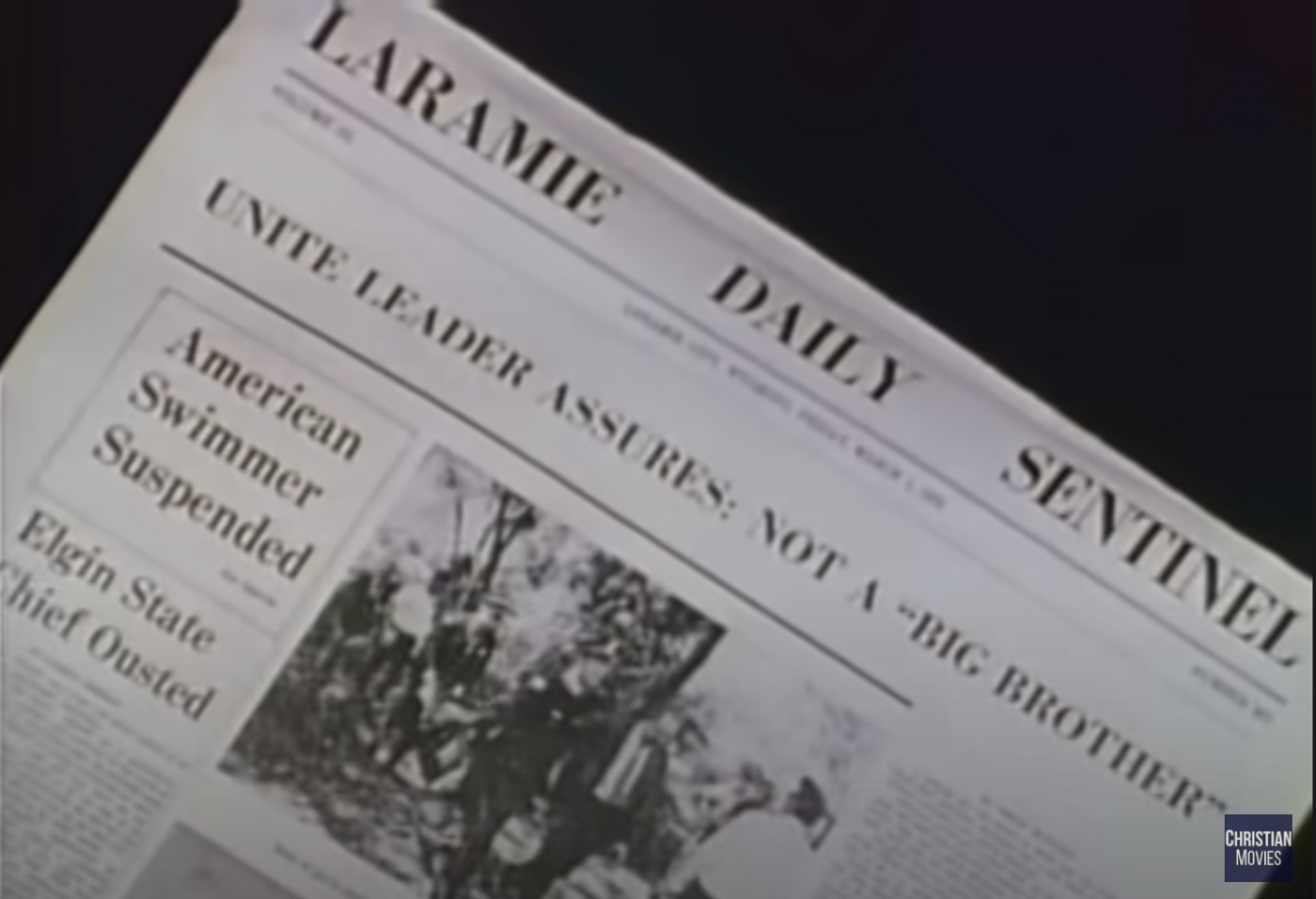
After an unknown amount of time has passed, we see the spokesman on TV again, explaining that everyone must now receive an identification mark, to prove their “citizenship”: the mark of the Beast.
Patty sees other people getting the mark, which takes the form of the digits “0110” (six in binary) repeated three times, and soon all the stores Patty passes have signs reading “citizens only” and featuring the mark.
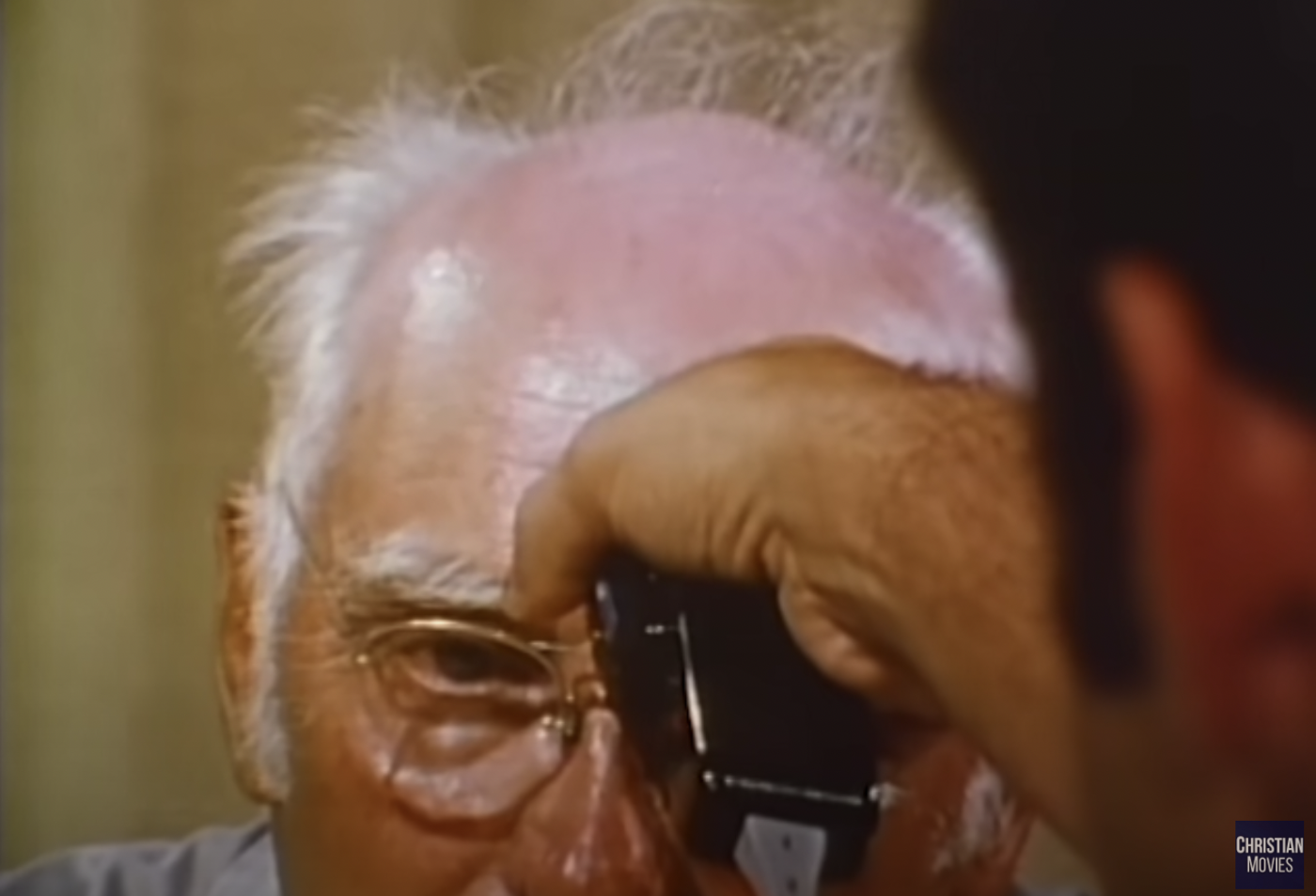
Patty refuses to get it herself, even after a later announcement that everyone must get the mark or face arrest and “prolonged inconvenience.”
I read the text in Revelation as saying that the mark is only required insofar as people need it to conduct commerce, but I guess you could also read it as saying the mark would be made mandatory and needing it for commerce is only the justification the Beast’s government gives.
At any rate, next there’s a sequence where UNITE soldiers chase Patty down in a white van that has “UNITE” on it in distractingly bad hand lettering. Wait a second…wolf in white van?
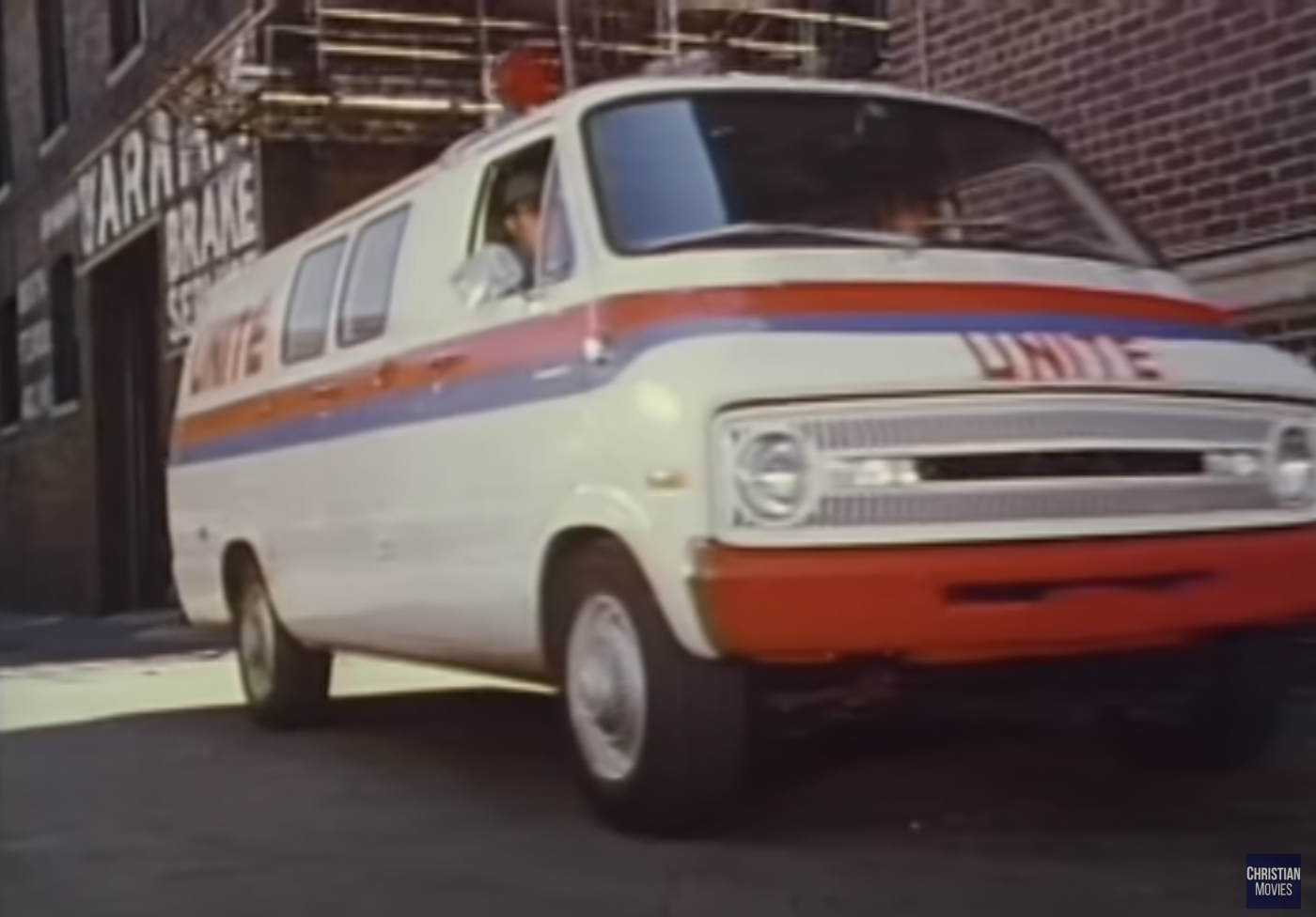
Patty is arrested but manages to escape, during which time she finds out that Reverend Turner, her humanist minister, has converted but been killed by UNITE.
The UNITE soldiers catch up to her on top of a dam, where she learns Diane and Jerry are working with them too, and during a struggle, Jerry pushes Patty off the dam to her death.
But then Patty wakes up, so we wonder for a moment if the whole film was a dream—until she discovers the exact same way, from the radio, that the rapture has happened. The end.
So, now, as promised, here’s how I think we’re supposed to read all this in the context of the later films.
Key:
Real: This exact event took place in the world of the filmsProphetic dream: Almost this exact event happens in the futureSemi-prophetic dream: An event kind of like this happens in the future, but not the way it’s depicted herePlausible dream: This event doesn’t take place but it easily could have
Events:
- Everything that happened before the rapture (all the plot points I described in Part III):
Real - The rapture happening, the first time we see it:
Prophetic dream - Formation of UNITE right afterwards:
Prophetic dream - UNITE requiring the mark to buy and sell:
Prophetic dream - UNITE making the mark mandatory:
Prophetic dream - Patty being chased down by UNITE and betrayed by Diane and Jerry:
Semi-prophetic dream - Reverend Turner getting killed by UNITE:
Plausible dream - The rapture happening after Patty wakes up at the end:
Real
Got it? Okay, moving on.
A Thief in the Night II: A Distant Thunder
The second film, A Distant Thunder, which came out in 1978, doesn’t make us deal with dreams vs. reality, at least.
But the maddening thing about it, and the rest of the series, is that although characters explain the prophecy as it appears in the Bible in great detail with the implication that it is an infallible guide to what’s going to happen next, we have to put together from scattered scraps of information, including Patty’s dreams, how these events actually manifest in the world of the films, and therefore why the characters take the actions they do.
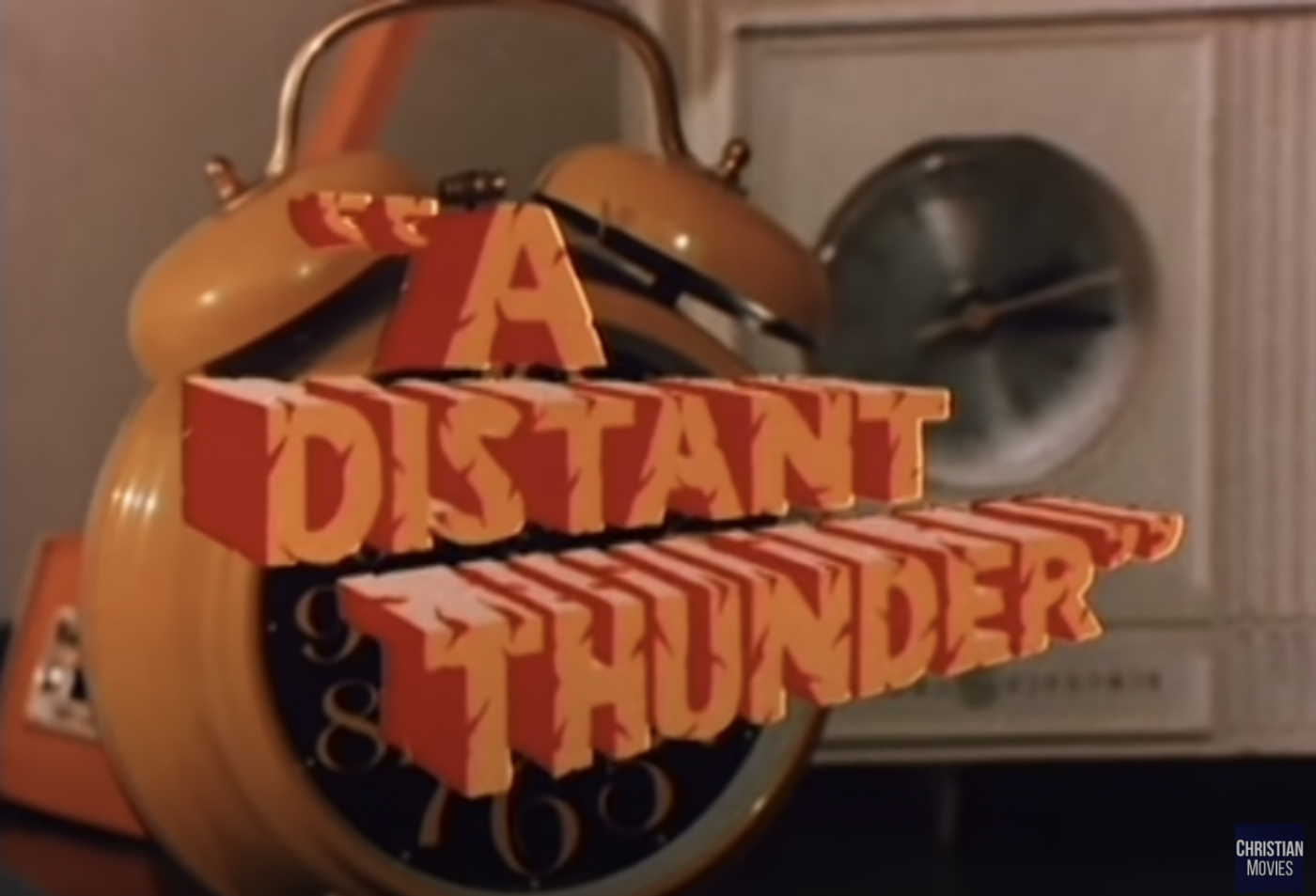
The degree to which summaries of the films on the Internet conflict with each other suggests that I’m not alone in having this experience. But the series is still a fascinating piece of culture to talk about, especially given the frankly bonkers amount of reach it has had—the alleged 300 million viewers of the first film is half the evangelicals in the world—so let’s get started now.
The plot of A Distant Thunder develops as a series of flashbacks, which take place during a scene in which Patty and her friends Sandy and Wenda are being held by UNITE in a packed church. A UNITE officer explains that everyone will be given overnight to reconsider their stance and then, in the morning, they will have a final chance to accept the identification mark, and if they refuse, they will then be executed.
As in the first film, this seems to conflate accepting the mark of the Beast with worshiping him; Revelation does say that everyone will have to worship the Beast or be killed, but worshiping the Beast isn’t introduced until the next film. That said, in Revelation, God combines the two as well, at least in terms of the consequences.
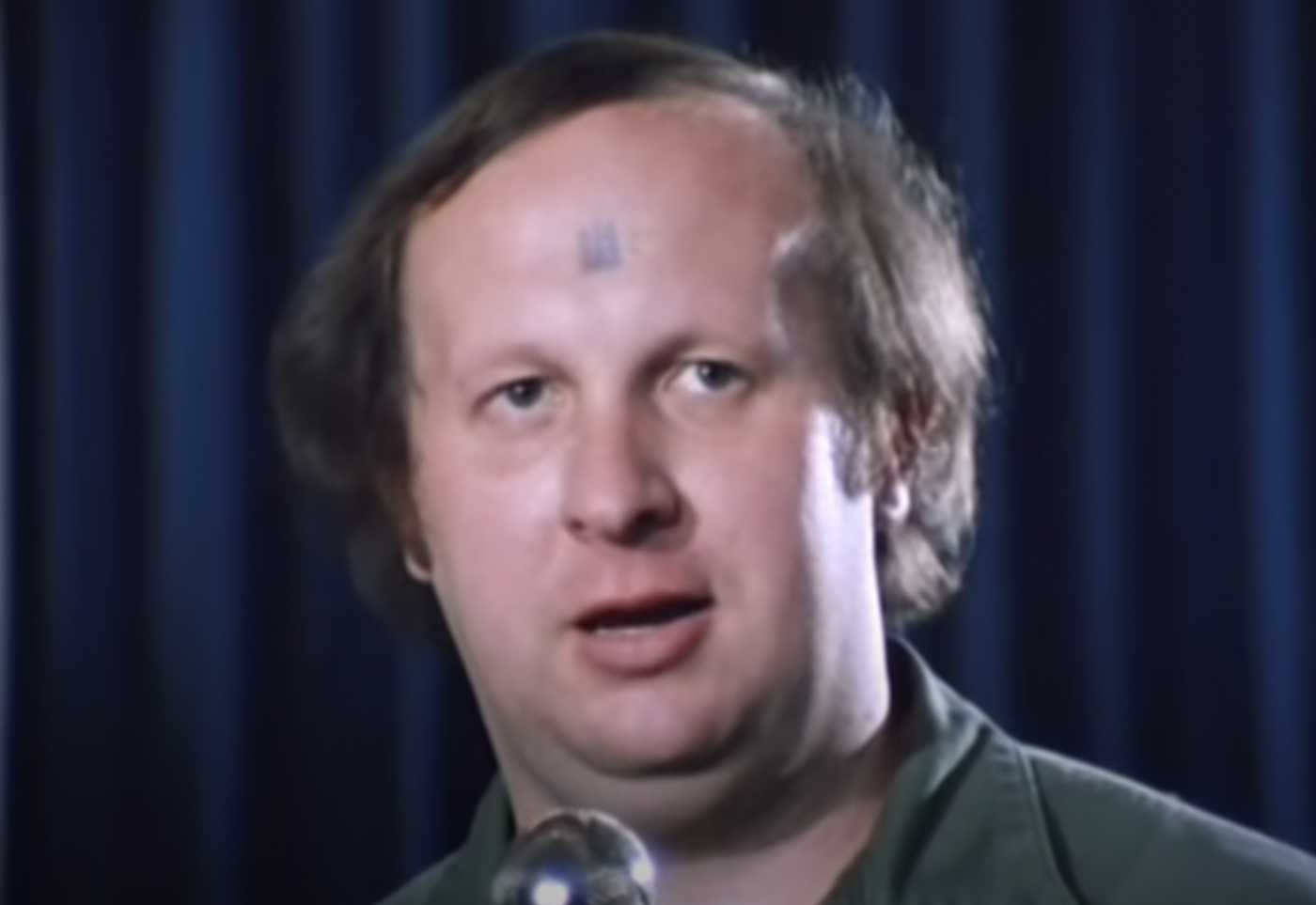
The officer reminds everyone that this last chance is thanks to the mercy of UNITE’s leader, who assured the newspaper in the first film that he was “not a Big Brother,” but who we now learn is actually called Brother Christopher. So now we know a little more about our Beast, but we don’t actually see him until the third film, which, given that it’s called Image of the Beast, would be a real letdown if we didn’t.
Overnight, in the church’s basement, an unnamed blond man and Wenda try to convince Patty that this is the last chance for her to commit to Jesus. According to them, if she doesn’t do so now, she forecloses on any outcome other than spending eternity in the lake of fire, whether she gives in and accepts the mark, or refuses and is executed without having converted.
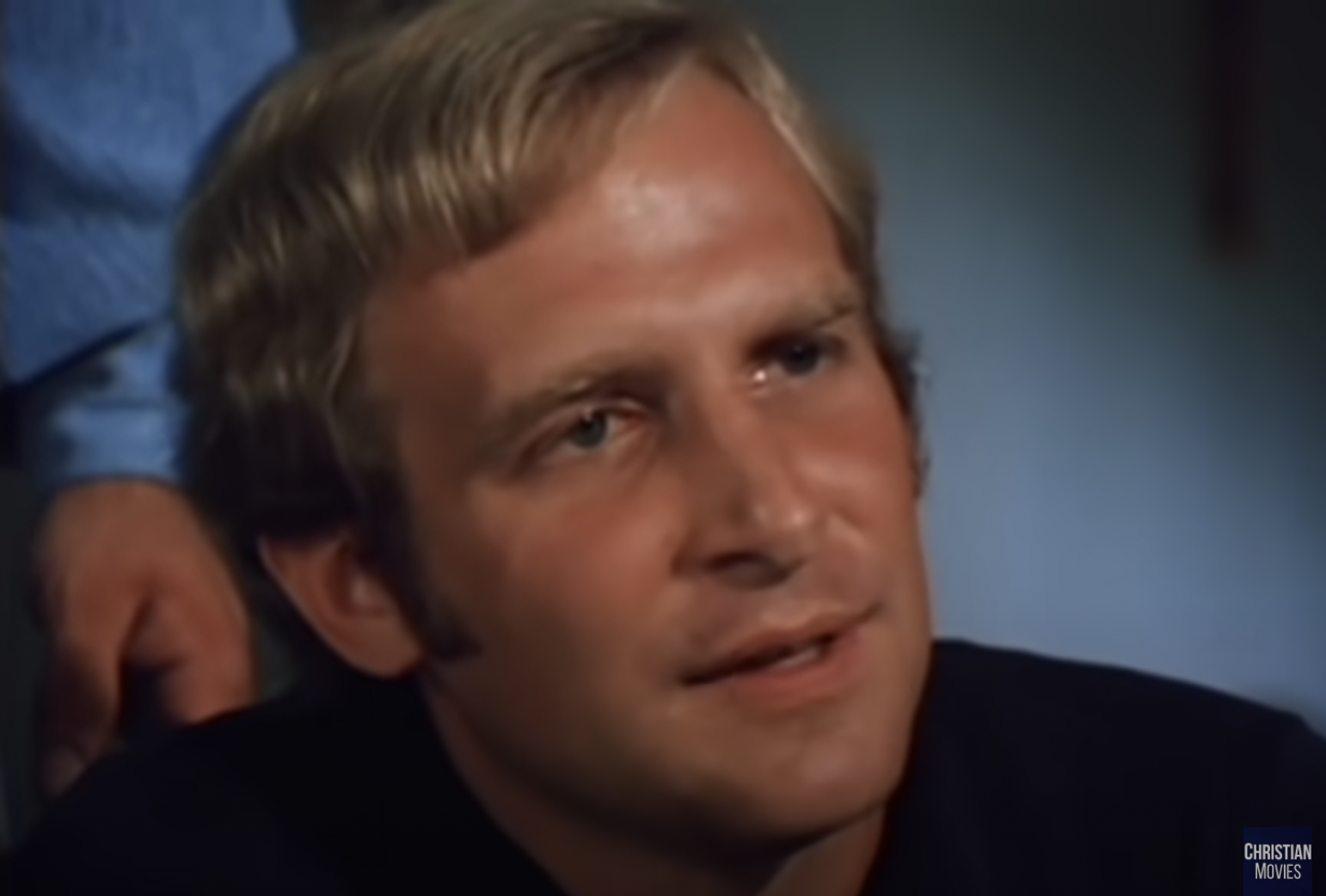
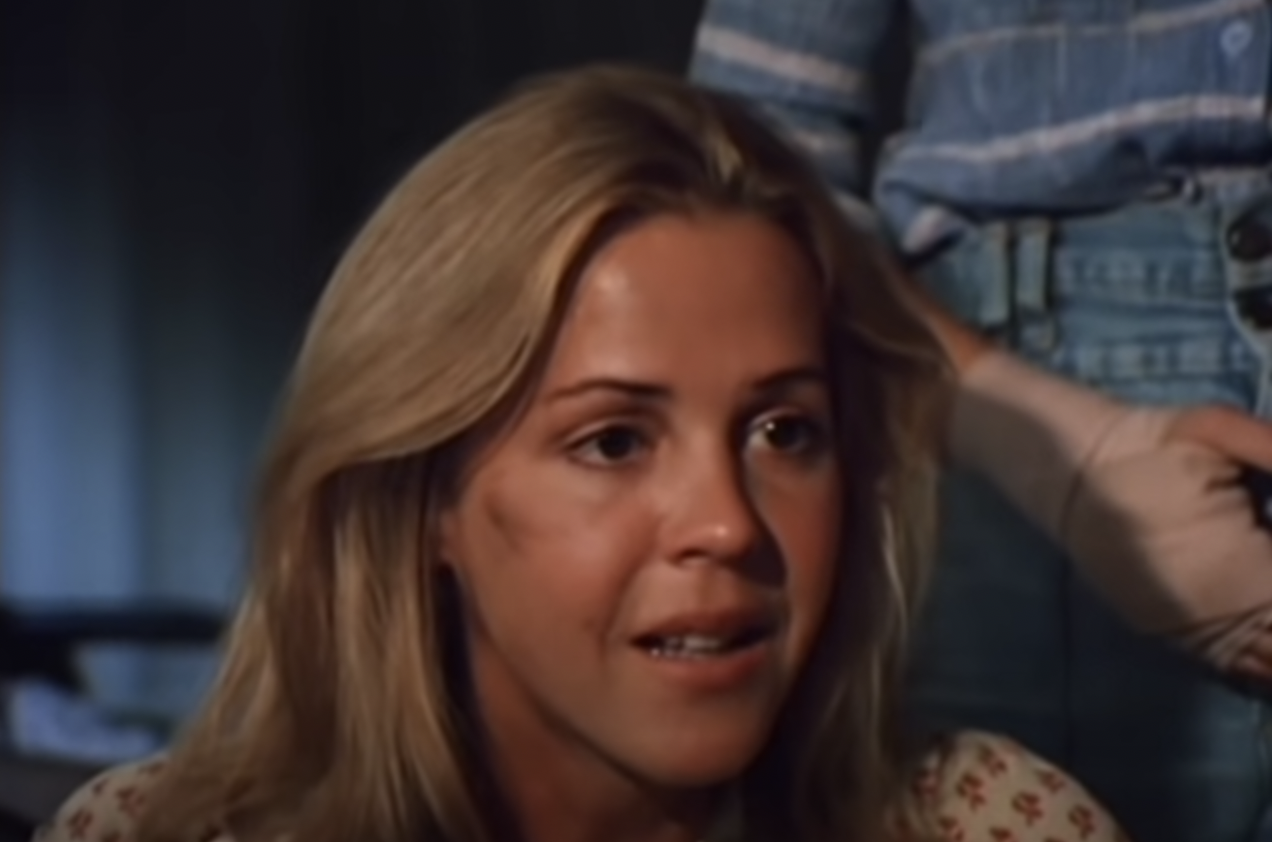
But although Patty now accepts that the lake of fire could be real, since so many other prophecies from Revelation have come to pass, she’s still conflicted and not ready to commit to this conception of Christianity instead of her own. She sees the dispensationalist versions of God and Jesus as being responsible for most of the bad things that have happened, which the others don’t contradict, because it’s not technically wrong. But unlike them, she can’t seem to pledge herself to anyone who would cause so much suffering.
Given the nature of her motivation and the apparent consequences, that is, being executed and burning forever, I have to wonder: might one consider Patty choosing not to convert before her death a more devoted form of martyrdom for her own Christian beliefs than accepting execution in this life solely in order to assure a good place in the next? Just a thought.
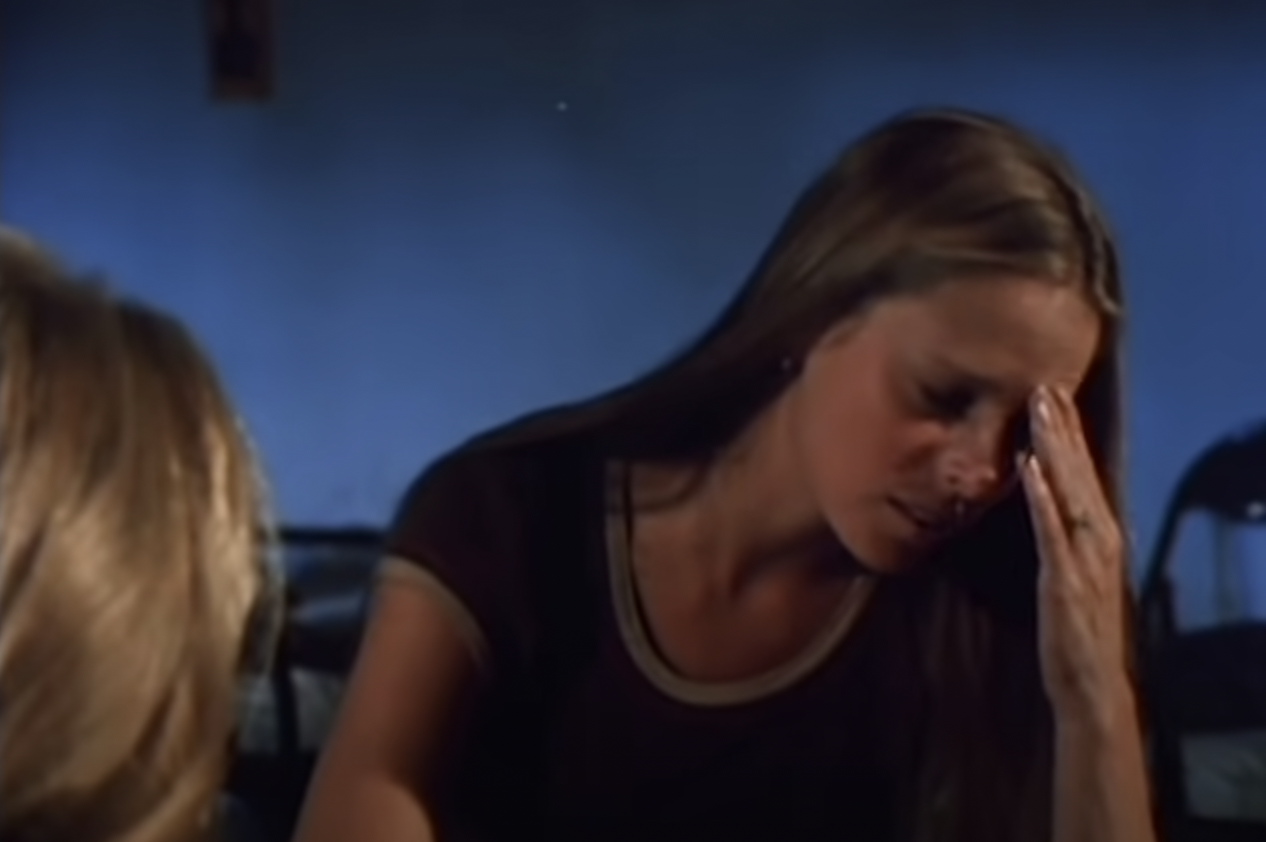
Anyway, we also learn from this conversation that it’s been around three years since the rapture, so, along with the presence of the mark, we seem to be around the halfway point of the tribulation.
Then the flashbacks start. The story picks up right after Patty wakes from her dream at the end of the first film and realizes the rapture has really happened. She drives to Jenny’s house, but as we are meant to assume in the first film, she’s gone. Next Patty tries her grandmother’s farmhouse, but she’s been raptured as well.
Finding the Leon Bates pamphlet I mentioned in the last post, on what to do if you’re left behind, reminds Patty of when her grandmother took her to church to see an evangelist explain the End Times prophecy. Like Pastor Barnes in Tribulation Force, the evangelist explicitly connects the first seal and horseman to the Beast and explains that he brings peace at first.
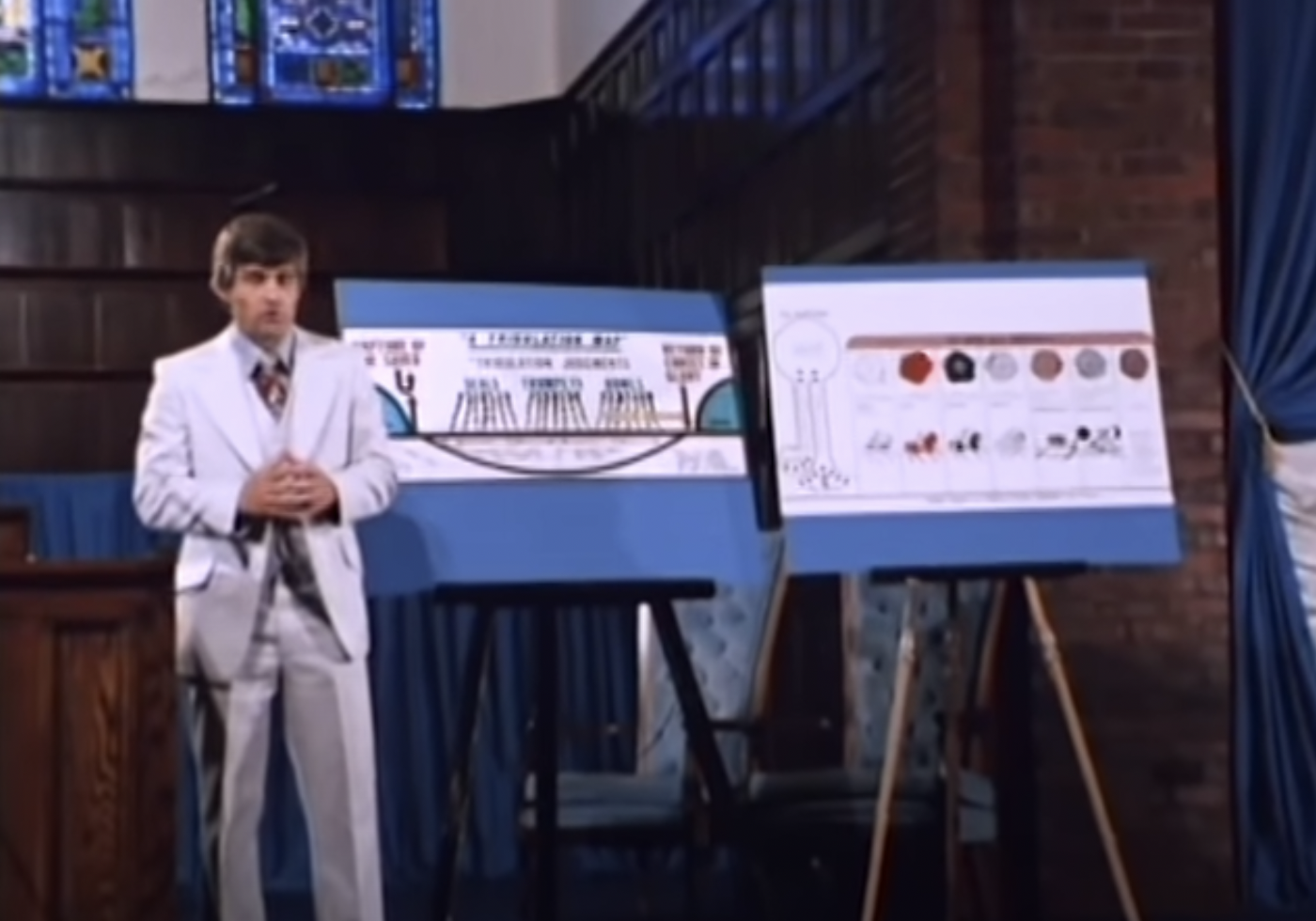
Reverend Turner was also in church that day, as was Patty’s friend Sandy, which underlines that all of them were instructed in dispensationalist beliefs before the rapture but rejected them—and in Patty’s case, she had them explained to her over and over and over.
After the sermon, we even see Patty’s grandmother answering all of Patty’s questions at length while making cookies.
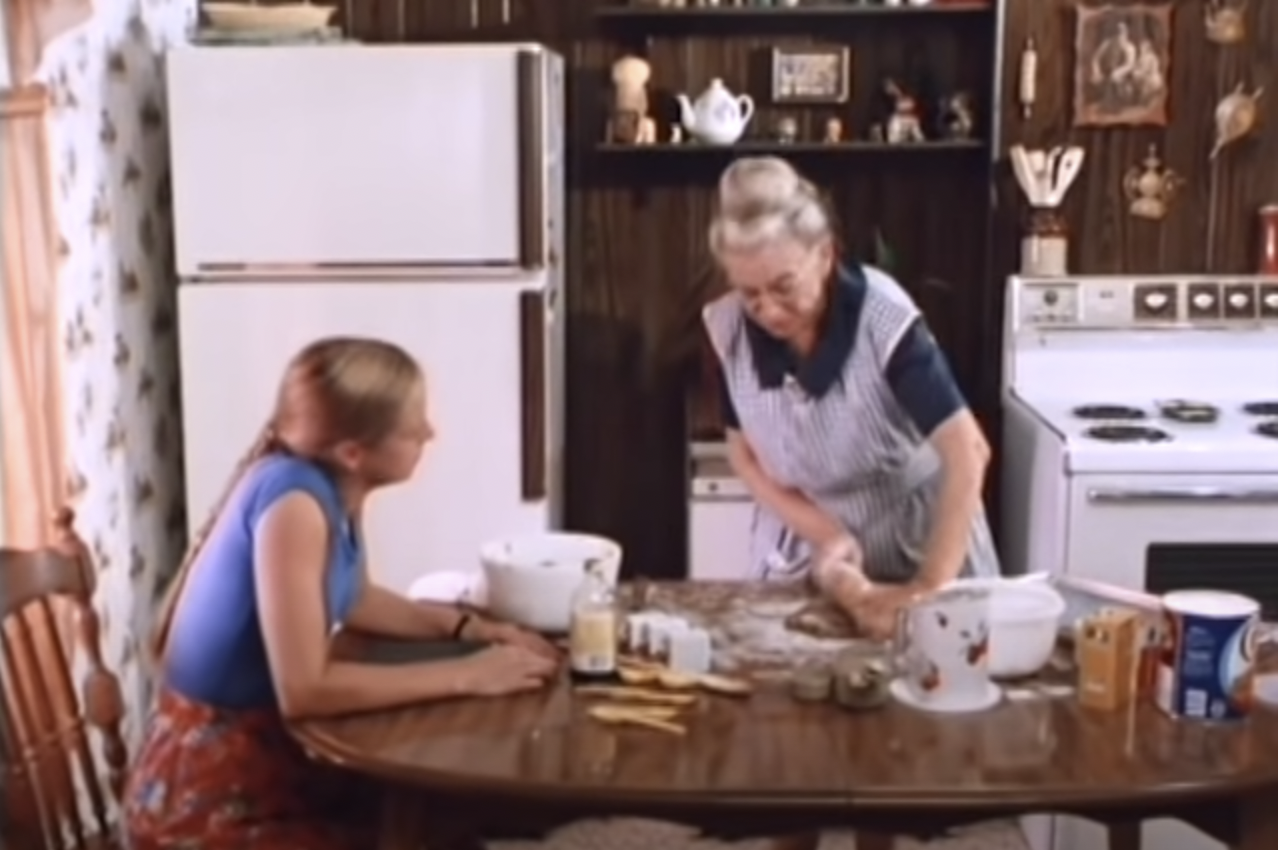
What that informed rejection means for the possibility of salvation is explored at length in the third and fourth films, but for now, it seems like everyone who tries to convert Patty after the rapture thinks that if she abandons her previous beliefs and commits to Jesus in the correct way now, she can still be saved.
Back in the post-rapture narrative, Patty decides to stay at her grandmother’s farmhouse and take care of her grandmother’s horses, and Sandy and Sandy’s sister Wenda move in too. Wenda’s husband and 18-month old daughter were raptured, but Wenda, similar to Patty, considered herself Christian but was not committed to Jesus in the right way. Sandy actually knows a fair amount about the Bible, but she just found it interesting and wasn’t a believer.
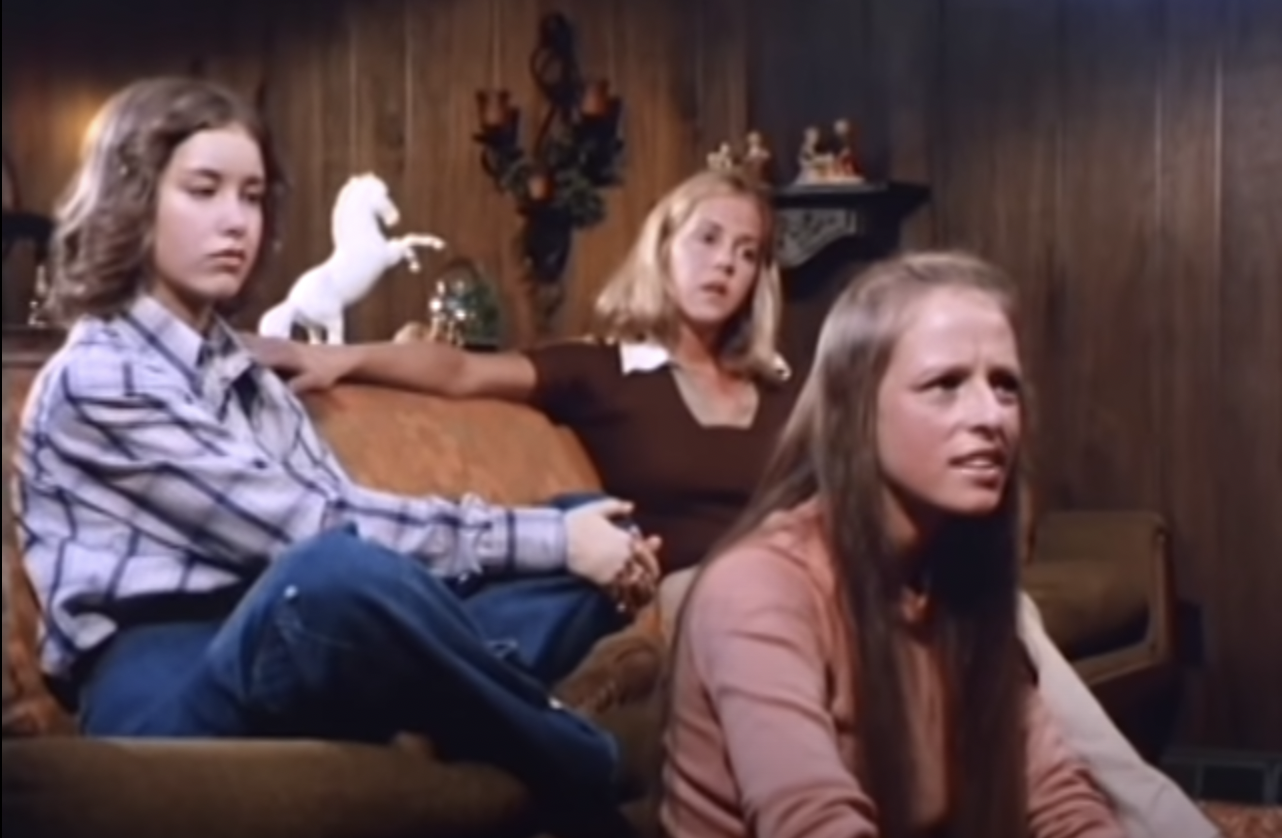
The three of them see Diane and Jerry from time to time, although Patty is suspicious of them because of her dream. One day, when the two are over, Sandy reads an article that reveals that Brother Christopher has signed a pact between UNITE and Israel. She says the evangelist they saw with Patty’s grandmother would say that Brother Christopher was the Beast and first horseman and that means the official start of the tribulation.
Nobody mentions the Temple of Jerusalem being rebuilt, but I think we can assume that was happening too, since that’s also considered a condition for the tribulation to start, and the Temple appears in the next film.
Now seems like a good point to include my diagram of the seven seals:
The seven seals

Jerry also mentions another article that says that two men, explicitly referred to as witnesses, have been mass-converting thousands of Jews in Jerusalem. Finally, they also discuss another recent piece blaming all the disappearances on UFOs, but it’s not clear if that’s UNITE’s official position, and only Jerry seems to entertain it at all. For some reason I didn’t find that as jarring as Nicolae’s background radiation explanation in Left Behind, however.
At some point later, while he’s at work, Jerry sees a TV news update on World War III, which is now apparently happening: there’s been a nuclear detonation in Uganda. Who’s actually fighting who isn’t clear and it doesn’t seem to have affected Laramie, Wyoming. Regardless, that’s seal and horseman number two.
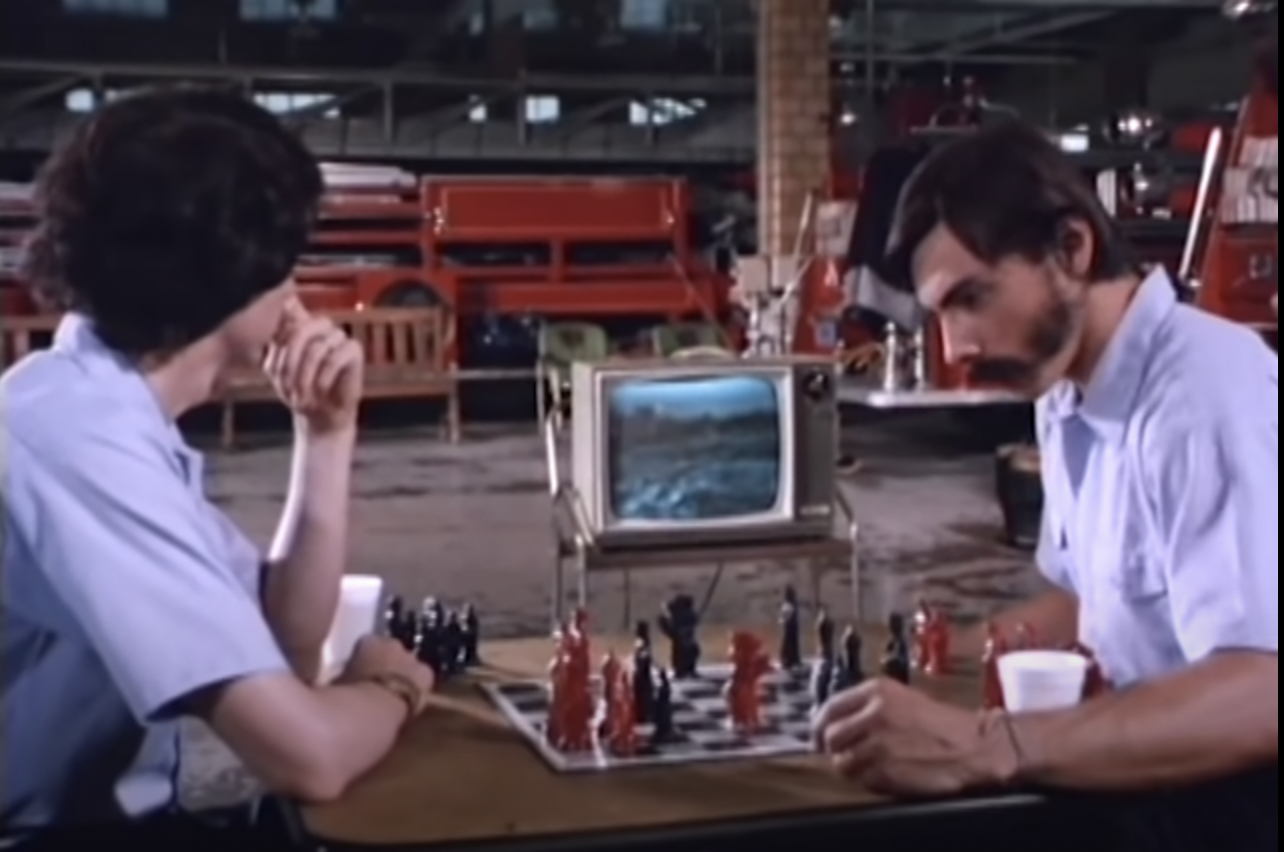
Meanwhile, Patty and Sandy and Wenda go see Reverend Turner preach in an almost empty church.
Turner disparages everyone who is going to the humanistic World Church instead—presumably this is the new one world religion before it explicitly switches to Beast worship at the halfway mark of the tribulation—and his sermon now reflects acceptable dispensationalist beliefs. He explains that what with a recent global famine, we’re now three seals and horsemen deep, and next up is the fourth seal and horseman: death.
Turner also admits that it haunts him that members of his flock who have died have ended up in eternal torment because they followed what he was preaching before. When Patty talks to him alone after his sermon, however, he grows angry and says it was Patty’s own fault that she listened to him: “If you had a Bible and it conflicted with what I had to say, then you should have challenged me.”
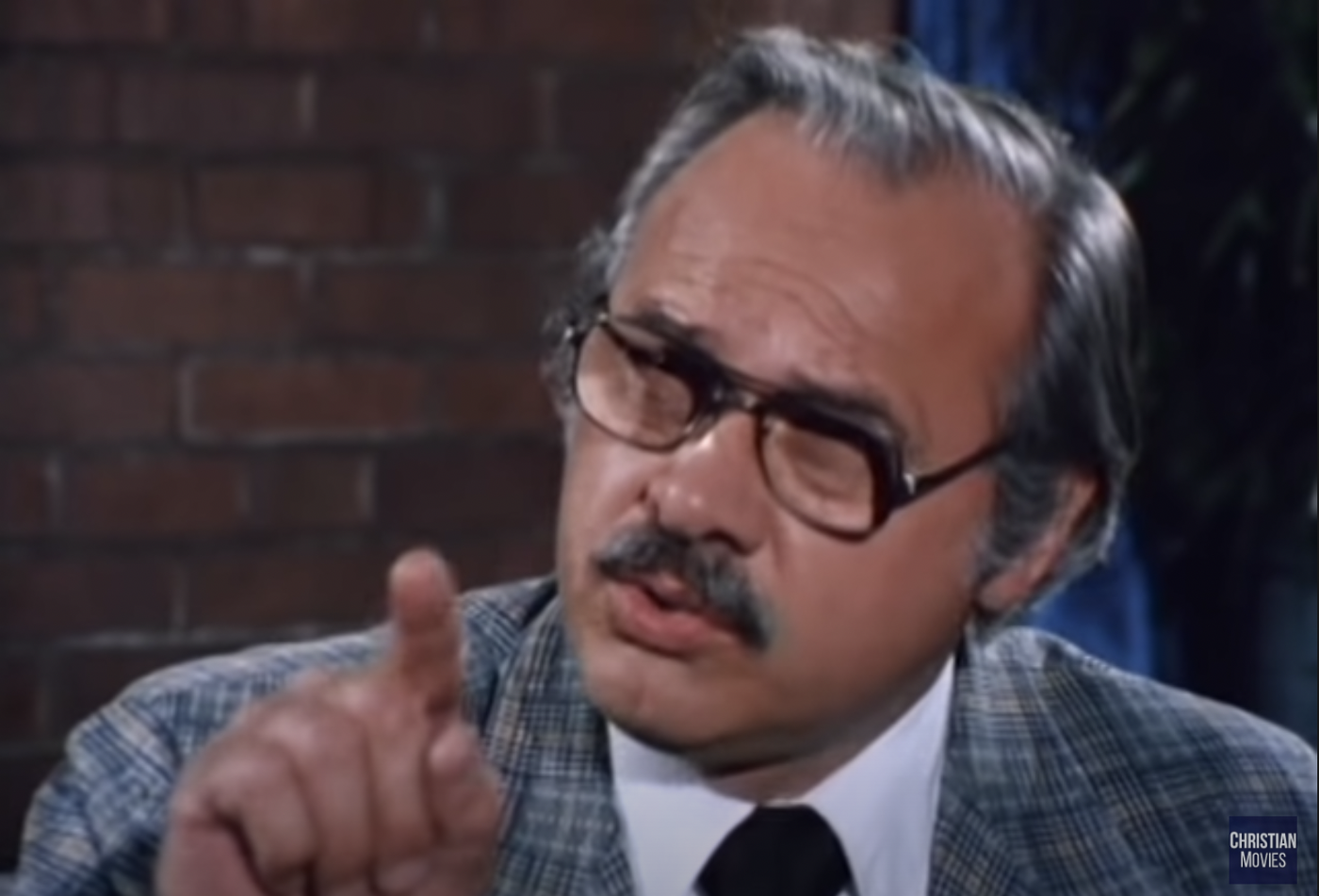
While they are out riding Patty’s grandmother’s horses, one of the witnesses, who is played by Doughten’s son, appears to them. After speaking with him, Wenda commits to Jesus. The three women also later briefly meet an old man named Jonathan. That night, however, the barn burns down, which is one way of resolving the horse question before it gets any harder to take care of the horses.
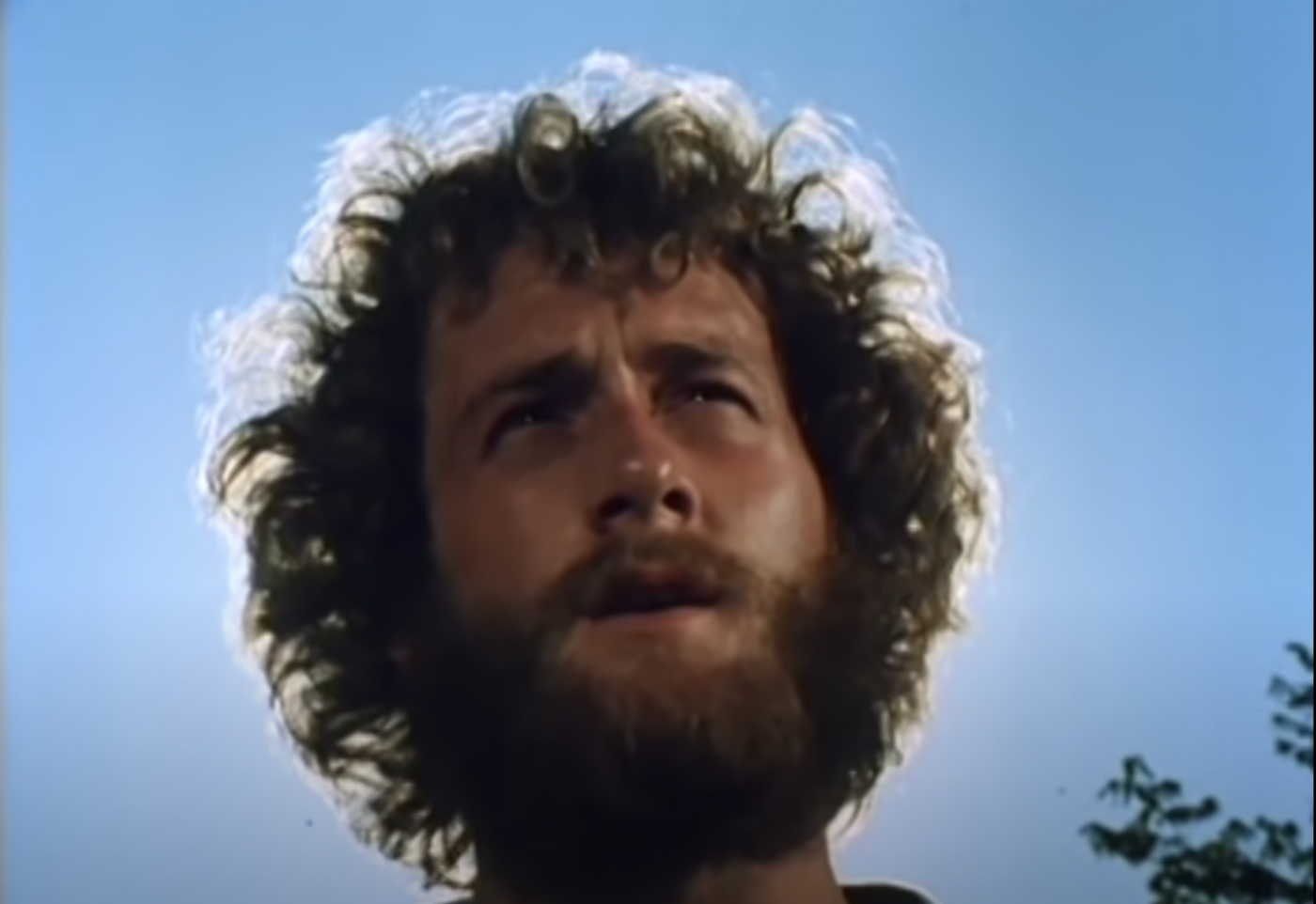
Soon the news is full of reports of mass deaths due to all kinds of natural causes worldwide, and they even mention my favourite, the attacks by wild beasts, which is also when the 30–50 feral hogs defence for assault rifle ownership turns out to be reasonable after all.
In the midst of what is clearly the ride of the fourth horseman, UNITE finally implements the identification mark. Like in Patty’s dream, even though the mark of the Beast is optional at first, they won’t be able to buy anything they need like gas and groceries without it.
Regardless of their individual reasoning as to why, none of the characters plans to take it, and Diane steals a bunch of boxes of food bars from her work at a charity that she offers to share with the others. Clearly they haven’t been prepping for this day like televangelist, convicted fraudster, and alleged drug-assisted rapist Jim Bakker with his food buckets, which is such a wild TV segment I feel compelled to interrupt the narrative and post a screenshot in line too:

Even though Patty hasn’t herself committed herself in the proper way, after everything that has happened she evidently now believes the prophecy enough to warn Wenda that introducing the mark might be the first step toward UNITE killing believers like her, just like Grandma told her would happen.
Patty has to meet Diane halfway between their houses to pick up the food bars, since she’s low on gas, and that turns out to be . . . on the dam. When she arrives and sees Jerry and Diane waiting, she relives part of her dream, panics, and pulls a 180.

Jerry and Diane jump in their car and catch up with her — but it turns out they don’t have the mark and as her friend, they’re worried about her mental health.
Patty and Sandy and Wenda spend the next month hiding out on the farm, living on food bars, and doing puzzles. The timing gets weird here but I think by now the mark has become mandatory for everyone (although Beast worship has clearly not, however), even though we see Patty hearing about the mark being required on the news later on. This is the only way what happens next makes sense to me, at any rate.
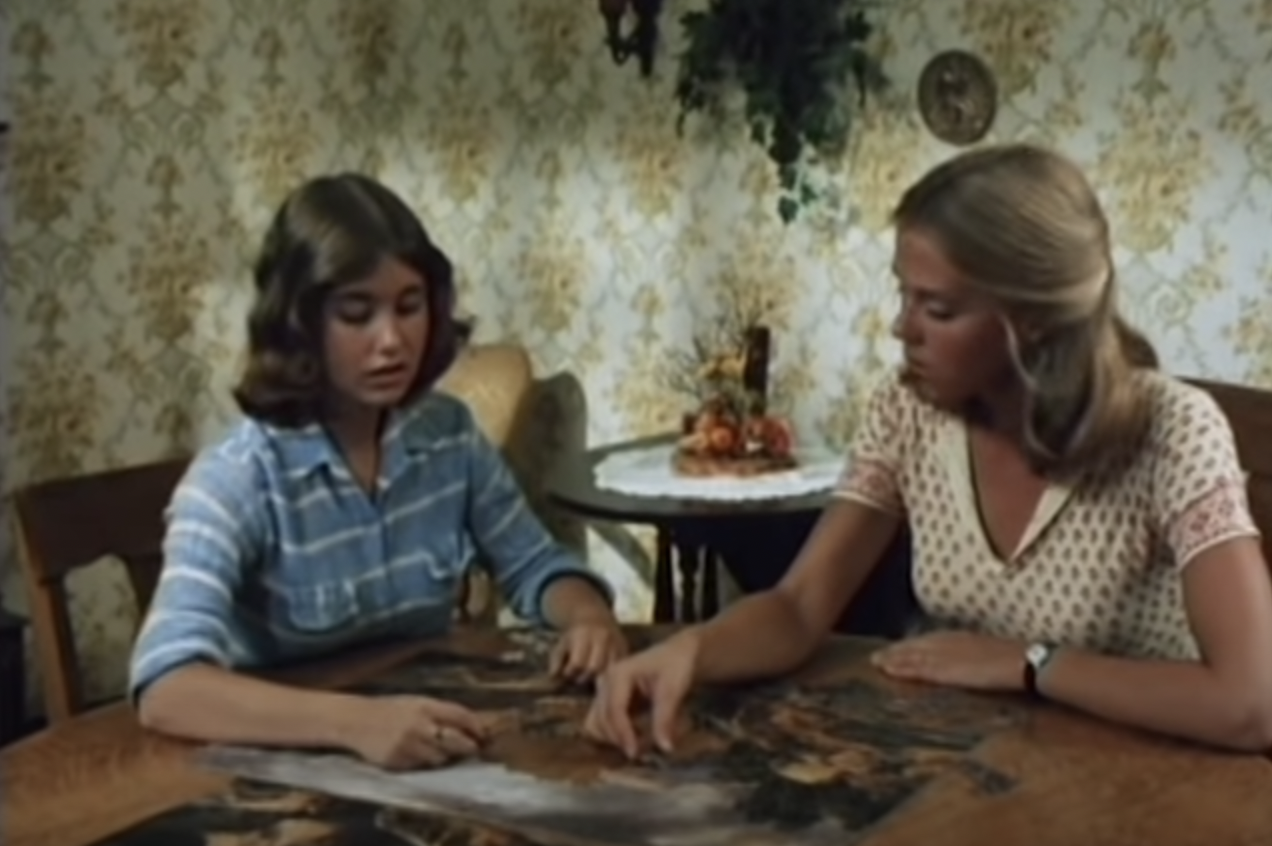
Regardless, sick of being cooped up, Sandy and Wenda risk a trip outside. They run into Jonathan in the park and Wenda invites him to come over later. But it turns out he has been hiding his mark, and he’s betrayed them, as they are shortly arrested by UNITE soldiers.
Wenda’s arm is injured during the scuffle and she and Sandy are taken to a doctor’s office so Wenda can get treatment before whatever’s coming. The doctor is frank with Wenda when she asks what will happen to them: as we know from the framing narrative, they’ll be given one last chance to get the mark or they’ll be executed. Again, conflating getting the mark with worshiping the Beast, this also reflects what Patty previously mentioned—that more believers will be killed for their faith, which is prophesied in the fifth seal.
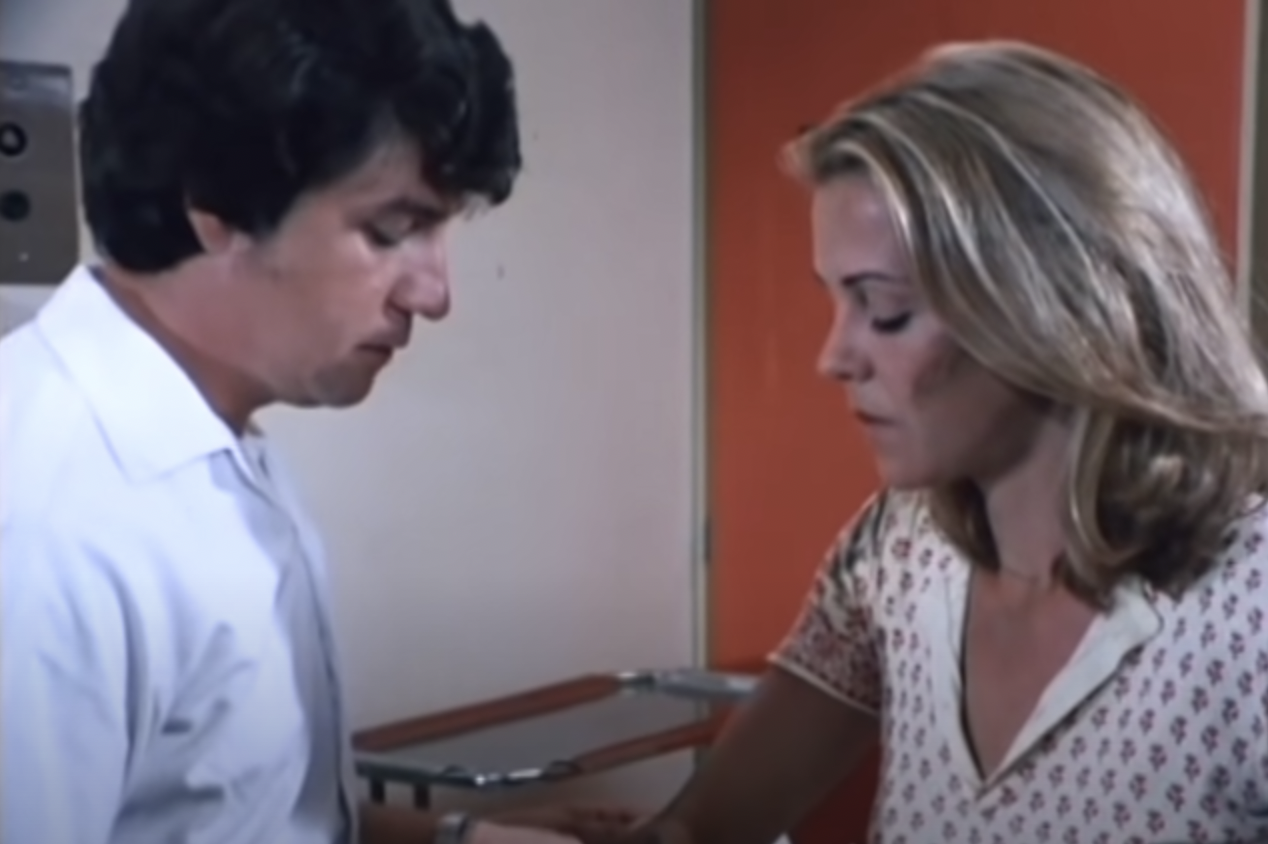
The doctor also somehow knows they met the witness, which Jonathan wouldn’t have known about. When the doctor leaves the room for a moment, Wenda manages to phone Patty and warn her that UNITE agents will be coming for her, because she told Jonathan their address.
After a chase where she ends up being the one driving a UNITE van, Patty manages to get away from her pursuers and calls Jerry and Diane from a phone booth, asking them to hide her. When she shows up at their house, however, they tell her they’ve now taken the mark and she should too.
After all, despite all the bad things going on, mostly elsewhere in the world, life with the mark in Middle America is still considerably closer to how it was pre-rapture than life without it. But then UNITE catches up to her in front of Jerry and Diane’s and Patty is arrested as well.
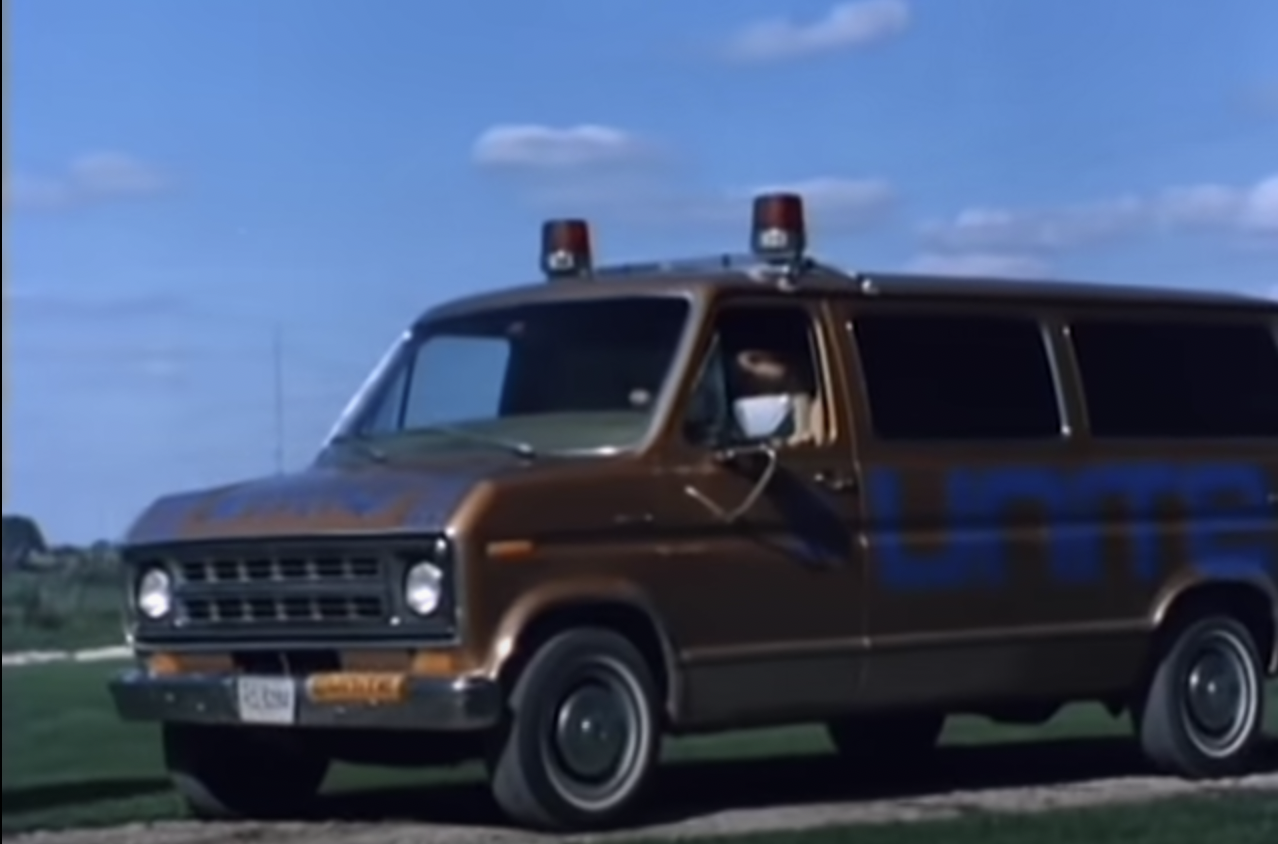
So now we’re caught up with the framing narrative. In the morning, Patty still hasn’t committed to Jesus in the right way when Patty and Wenda, but not Sandy for some reason, are taken outside the church with blindfolds on. When their blindfolds are removed they see the mode of execution: in keeping with Revelation, a still-bloody guillotine.
As promised, the guard gives them one last chance to change their minds and accept the mark, saying their friends have some words to say to them, and brings out Diane and Jerry—and Sandy. Who has the mark now too and it appears was also responsible for tipping UNITE off, presumably about the witness. So Patty and Wenda were actually betrayed by four different people who weren’t even working together. Trust no one, evidently.
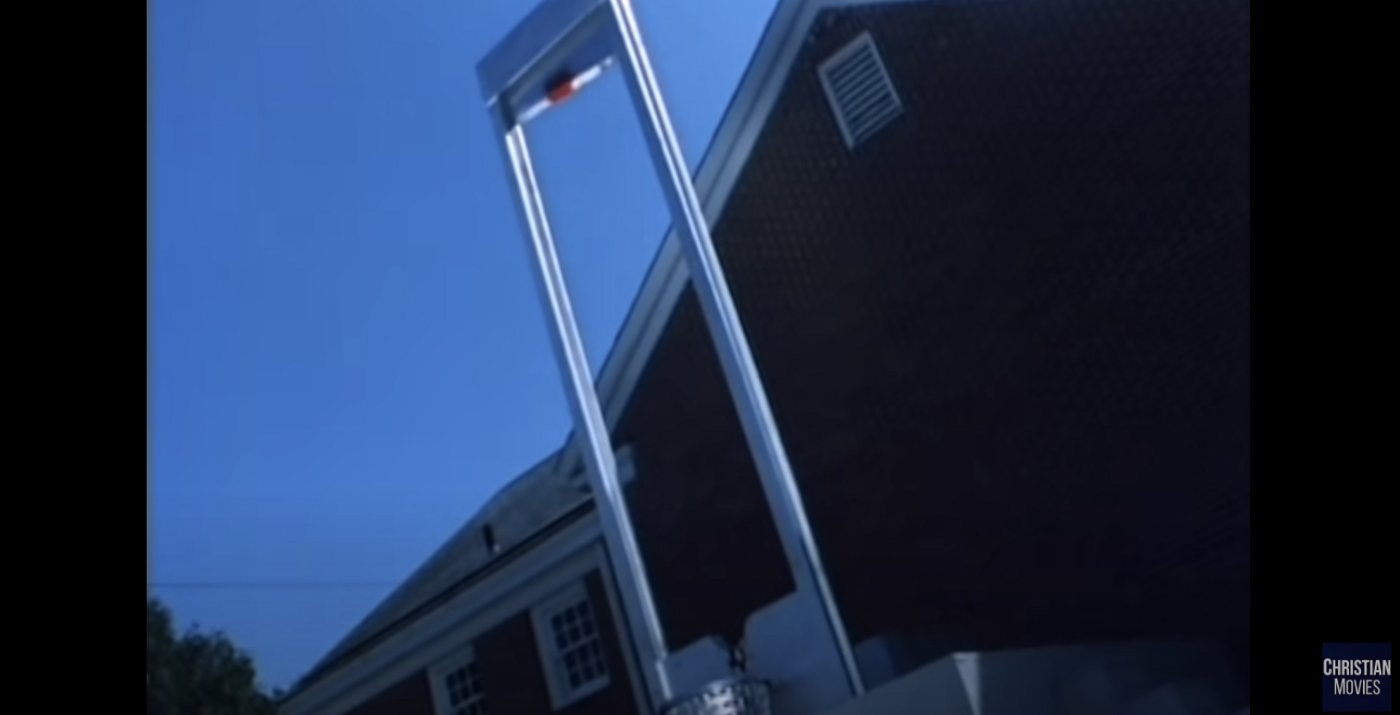
The movie ends with Wenda confirming her decision to remain devoted to Jesus instead of taking the mark—and then the sound of the blade.
A Thief in the Night III: The Image of the Beast
The Image of the Beast, released in 1981, begins pre-rapture with a new character Kathy, who we see heavily pregnant and grocery shopping with her husband. Kathy picks up a book called Computer Prophecies, which is sadly not real.
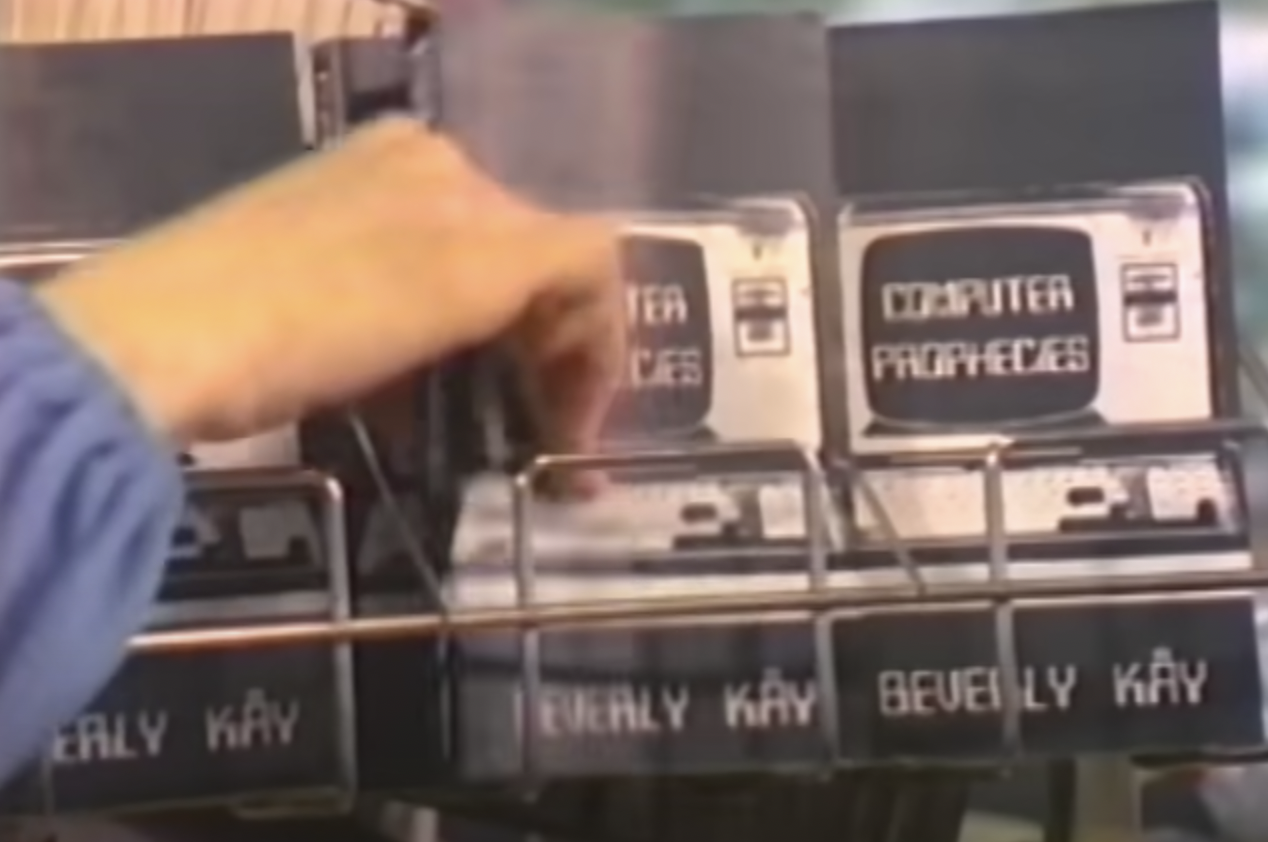
At the checkout they are served by none other than Patty, who asks if Kathy’s sure she wants the book—which is heavily promoted in her store—because it’s a scary religious book about people who worship computers. Patty’s husband says people should be scared now rather than scared during the tribulation, and Kathy says she’ll read it, even if she finds all this prophecy stuff hard to believe. Her husband says both of them have got to shape up or they’ll be in for a rude surprise. Guess which of them is gonna get raptured?
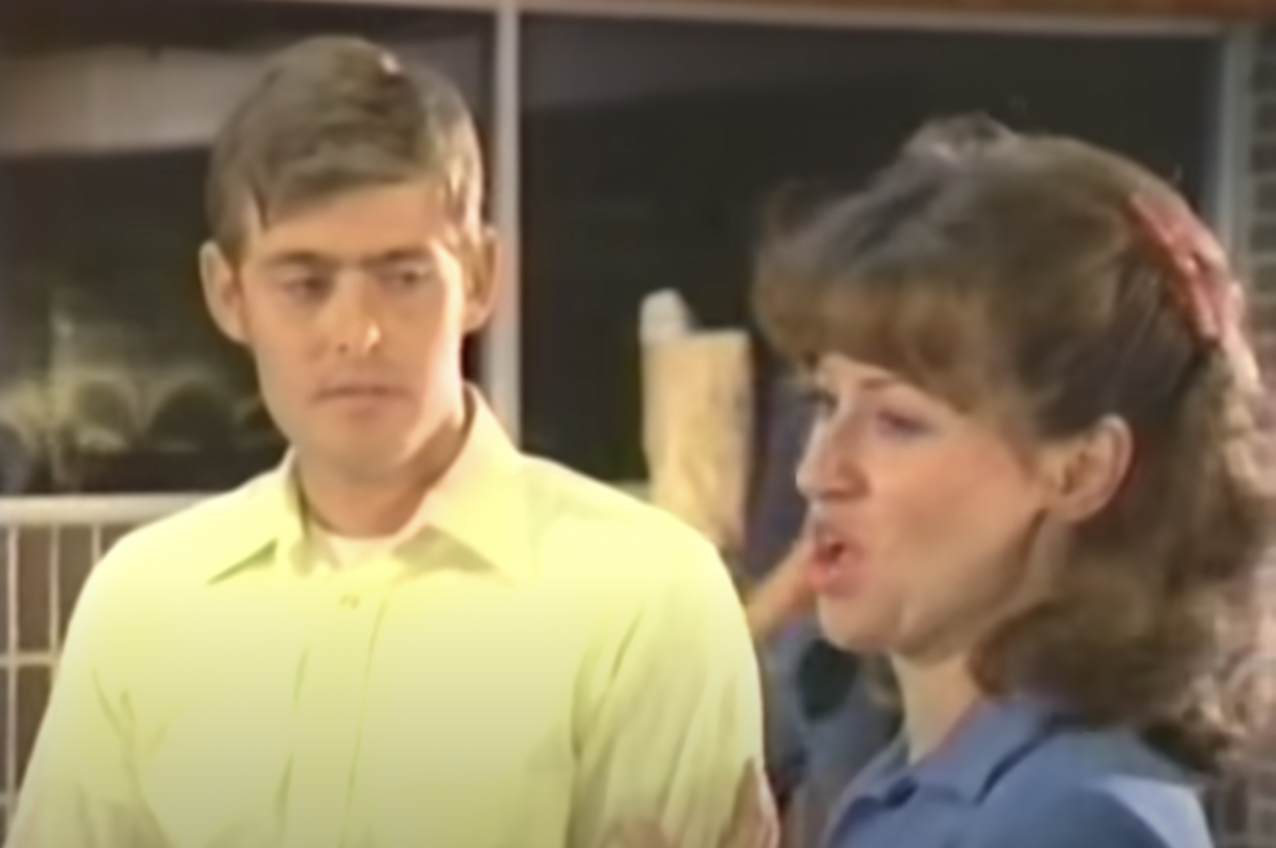
Next we go back to the events at the end of A Distant Thunder, as it cuts to Wenda’s headless body being carried off, and then Sandy begging Patty to take the mark.
Patty is still conflicted and doesn’t answer when the guard asks whether she will accept the mark, so she is placed in the guillotine — face up!—but then the prophesied earthquake from the sixth seal takes place as the sky turns black, and everyone else runs away.
Patty tries to free herself but can’t, and finally calls out that she’ll take the mark. But the guillotine blade works its way loose during the tremors and falls anyway. And, regardless of whether she could’ve been saved before or not, because she has now said yes to the mark, now Patty is unquestionably going to burn forever.
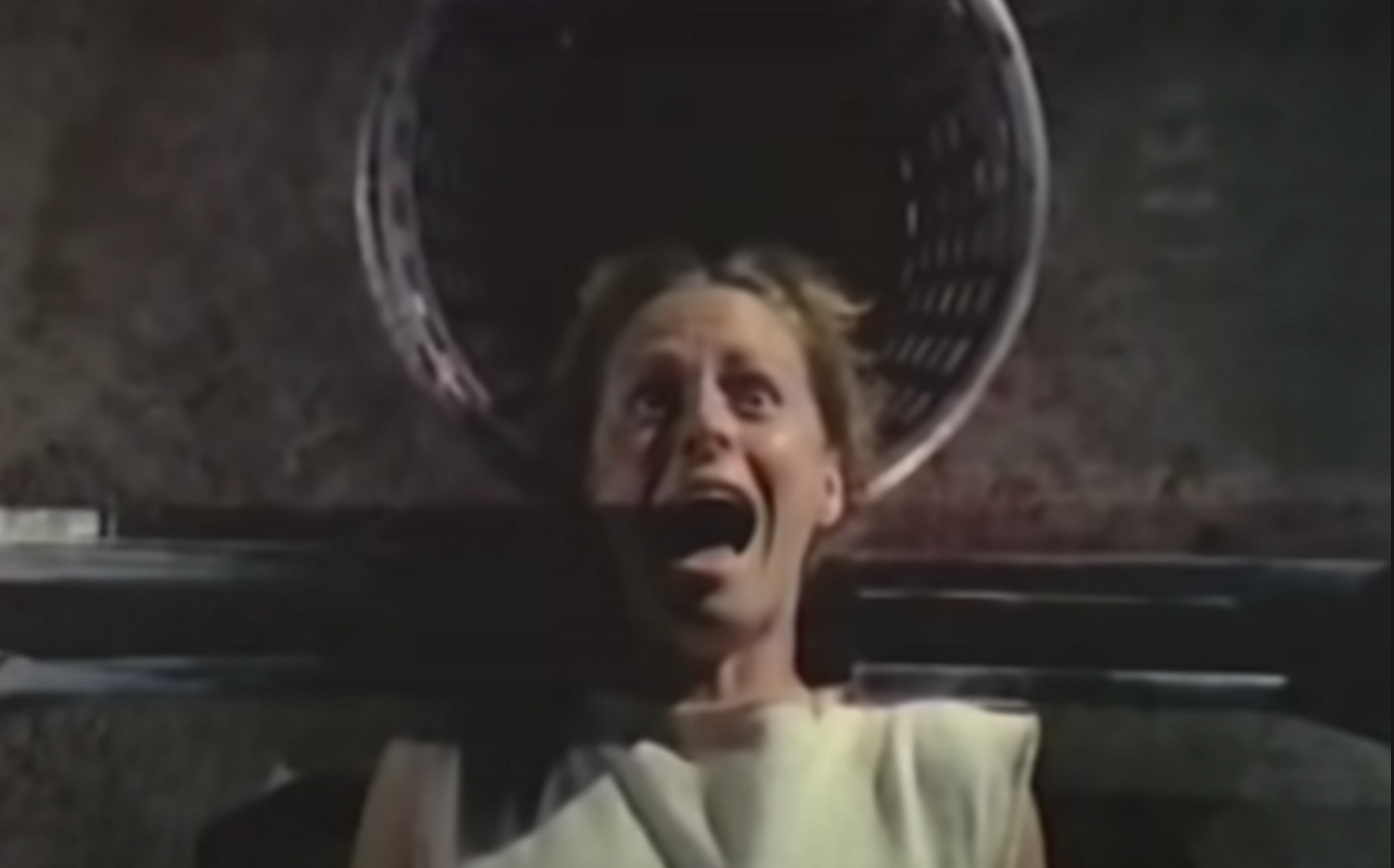
Now we see the new protagonist, David, escaping from a UNITE prison during the earthquake. He steals the uniform of a dead soldier and helps several others get out too: Kathy and her son Billy, and another woman, Leslie.
David wasn’t religious and was left behind when his two sons and his wife were raptured, but has fully committed himself to Jesus during the tribulation.
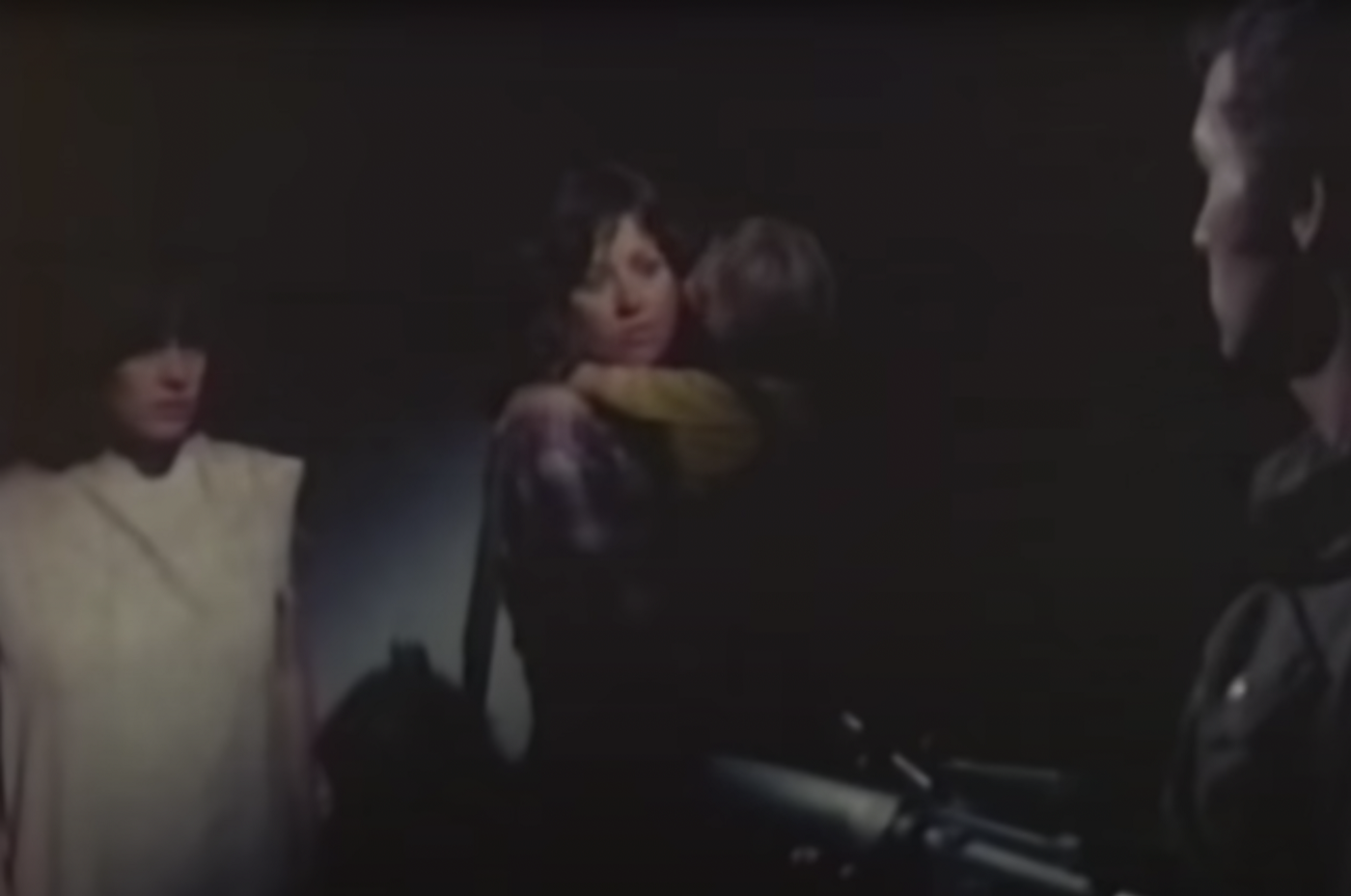
As we saw at the start of the film, Kathy’s husband was a believer, so he was raptured. Kathy was Christian but not in the right way and hasn’t converted yet. She did read in Computer Prophecies that if you take the mark, you’re going to the lake of fire, and she believes that at least, which is why she was in jail and presumably awaiting execution.
She also says that Billy was born several days after the rapture, making him around three years old, and revealing that fetal material wasn’t raptured in this world. This reflects that evangelicalism as a whole didn’t even start to circle the wagons around life beginning at conception until the late seventies.
Like Kathy, Leslie was also Christian but not correctly so, but she converted during the tribulation. Good thing, too, because when UNITE guards at a checkpoint get suspicious, Leslie is shot and it seems killed, and the others leave her and continue on.
Later on, when Billy wanders off and into someone’s house, David and Kathy meet the resident: Reverend Turner. He has now grown a huge beard and long hair and invites them to stay with him, his goats and chickens, and his giant Clarence Larkin-style diagrams, which he uses to explain to them (and us) what’s going on throughout the film.
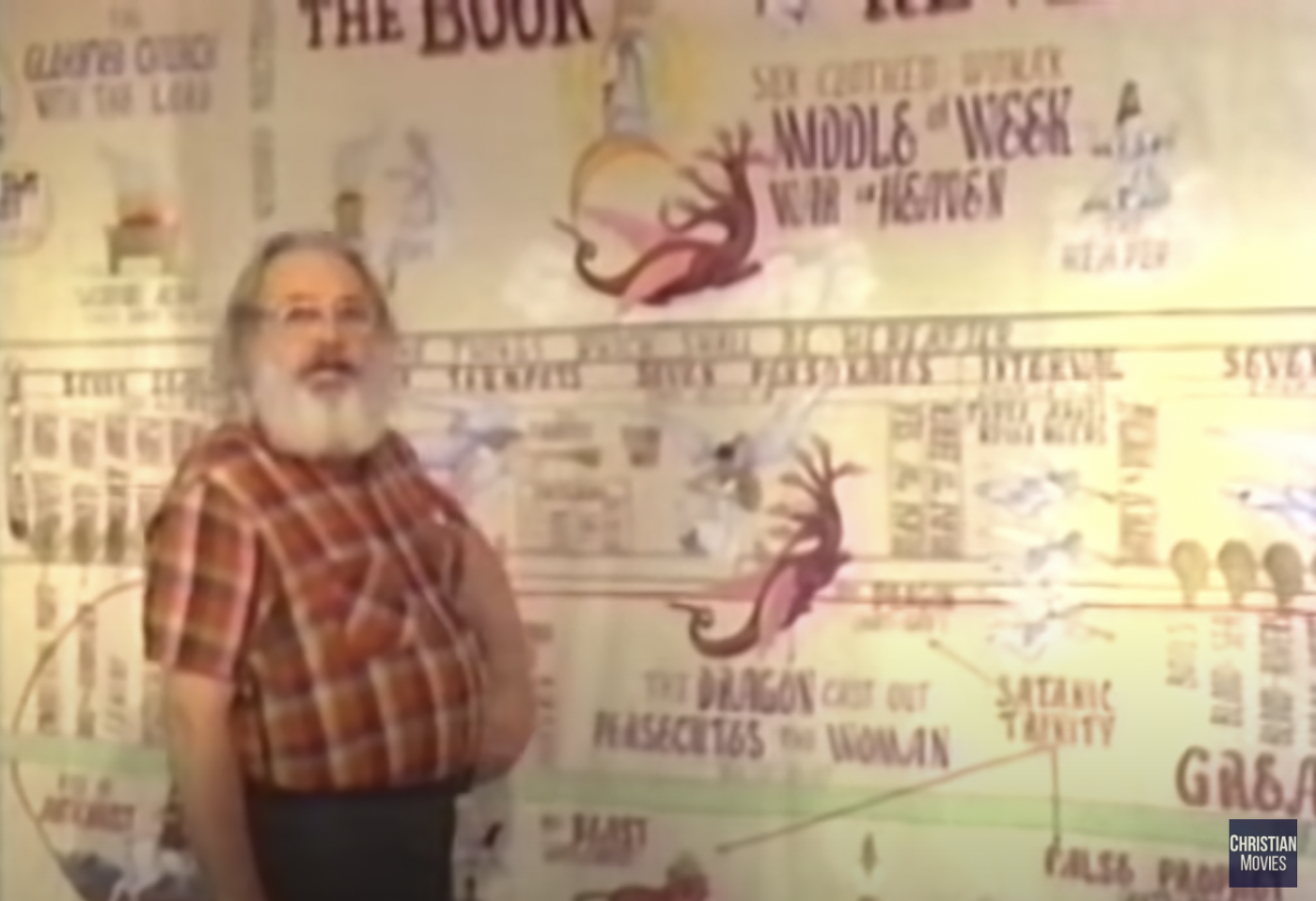
David explains that he is a programmer and he is developing an alternate mark that people can have imprinted on them that he believes will allow them to buy and sell without the actual mark of the Beast. He convinces Kathy, who it turns out is a computer analyst who previously worked for a company called Computers Incorporated, to help him with his plan.
They start out by using the artificial mark to pass through UNITE checkpoints, and that mostly goes well. But when they see the UNITE officer who shot Leslie they duck into World Church, which was referenced by Reverend Turner in one of the flashbacks in the previous film, and is now the only permitted religion. Diane and Jerry turn out to be attending the service and we see Kathy and Diane know each other too.
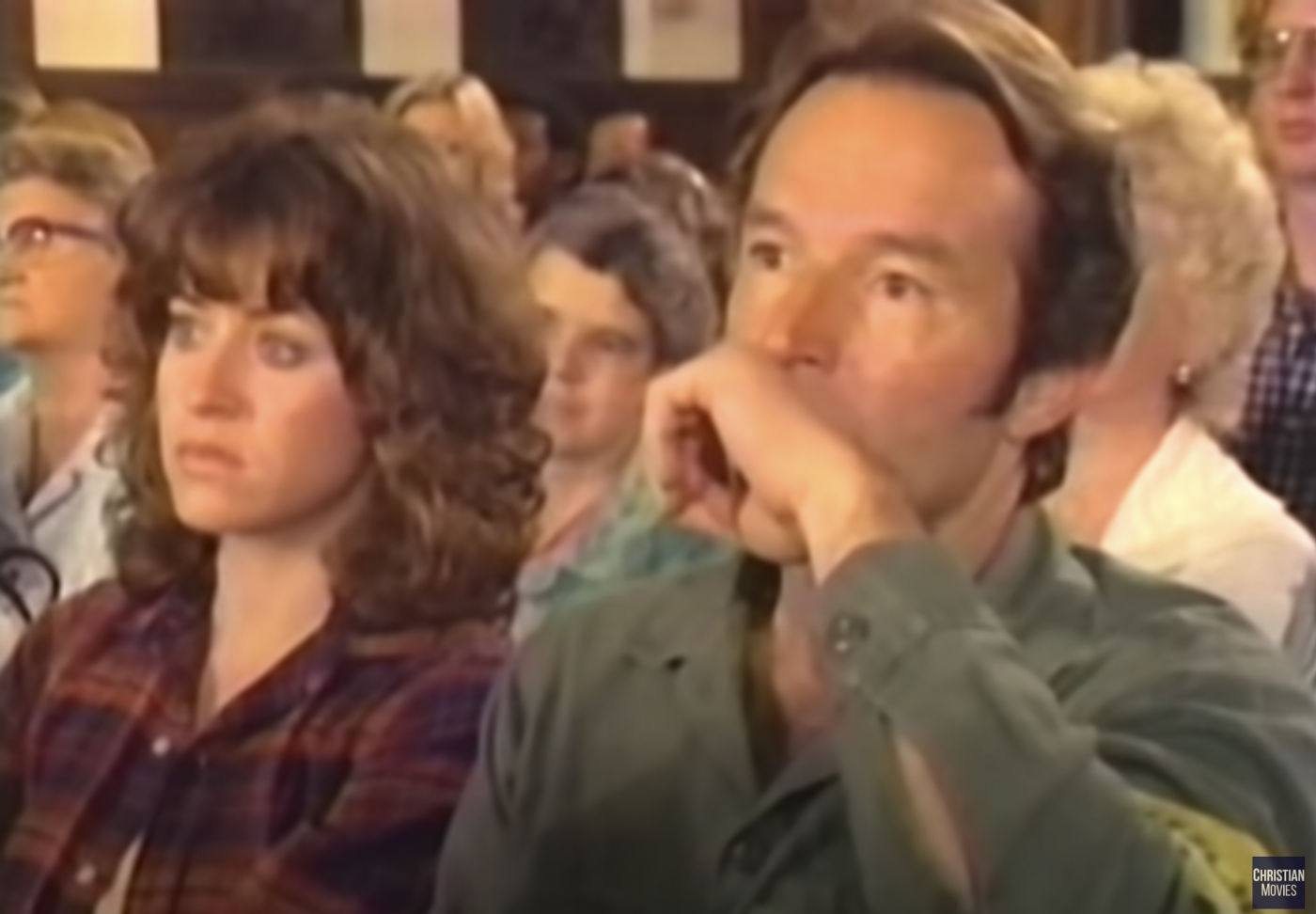
World Church is still not about worshiping the Beast at this point; Turner tells them after they come back and share their experience that it arose organically from all the “false” approaches to religion collapsing together after the believers were raptured, and UNITE took advantage of the presence of a religion that didn’t threaten them and made it official. Turner stretches a bit and compares it to the Prostitute of Babylon, committing adultery with and exercising power over kings and merchants.
But, to be fair, as David and Kathy walk in, the preacher is explaining to his flock how all the wars going on now, which we know are caused by the second and fourth horsemen, are good for everyone’s investments.
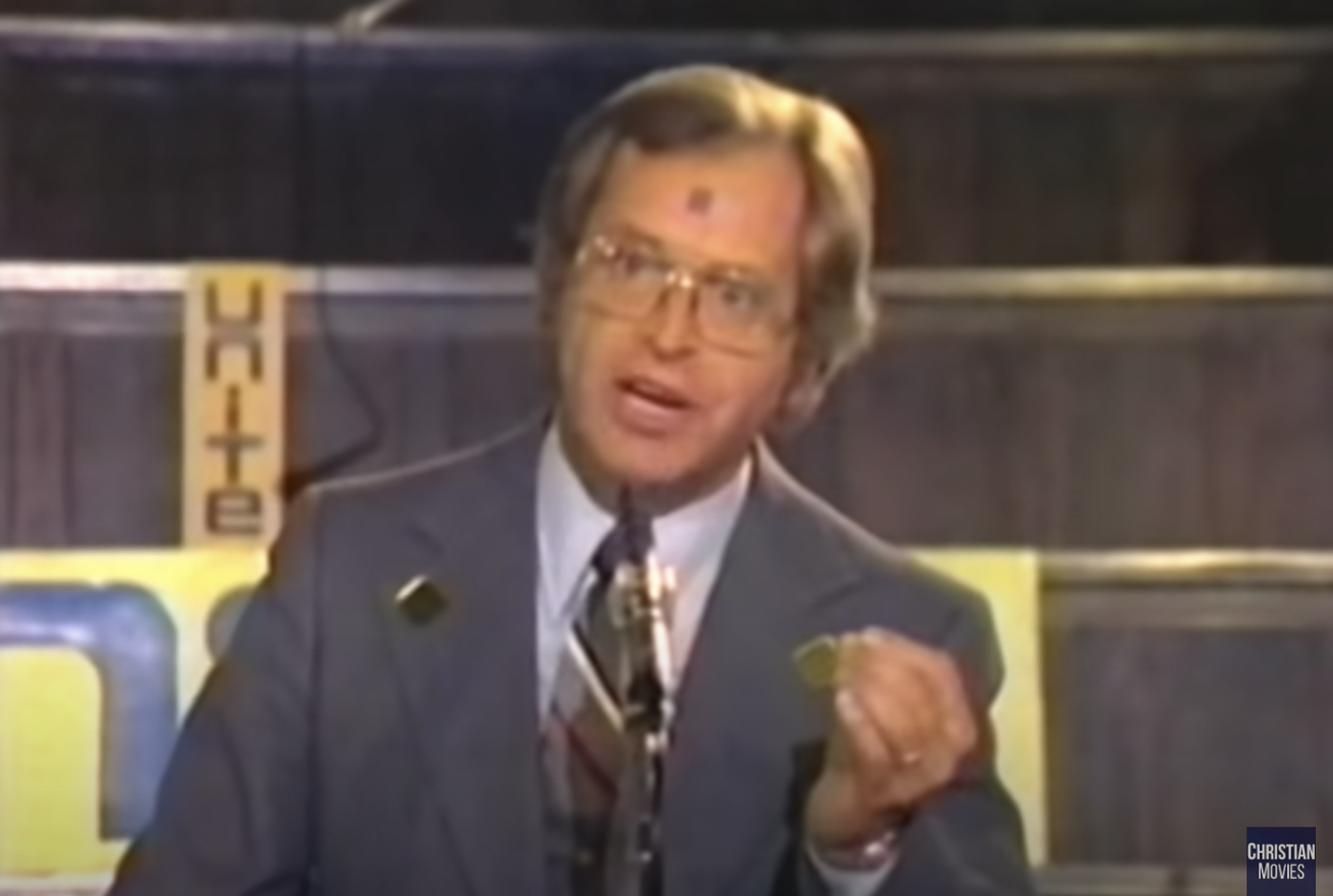
The preacher also mentions that Israel is geopolitically important because of its oil fields (in 2022, it is 95th in the world when it comes to oil production, but I have no idea about the potential for it to produce more) and facing a war with Russia. But Brother Christopher has aligned UNITE militarily with Israel.
Russia attacking Israel is a surprisingly common interpretation of the Battle of Gog in Ezekiel, but God is explicitly said to be the one who intervenes on Israel’s behalf, with fire from the sky and such. I was planning on waiting to get into it until Part VI, since it often shows up in dispensationalist content as a sign the rapture is imminent, but I recently learned that some see it taking place partway through the tribulation and the roles being different.
J. Dwight Pentecost, who I mentioned last time, combines Ezekiel with all the interminable military maneuvering in Daniel to portray the Beast as fighting a whole campaign in the Middle East that culminates in the Battle of Armageddon as described in Revelation, which appears to be what the filmmakers are getting at here.
Starting off a burst of news updates, a TV news report reveals that Russia (and Egypt) did attack Israel, but with the help of Brother Christopher, as per Pentecost’s view, Israel has triumphed.
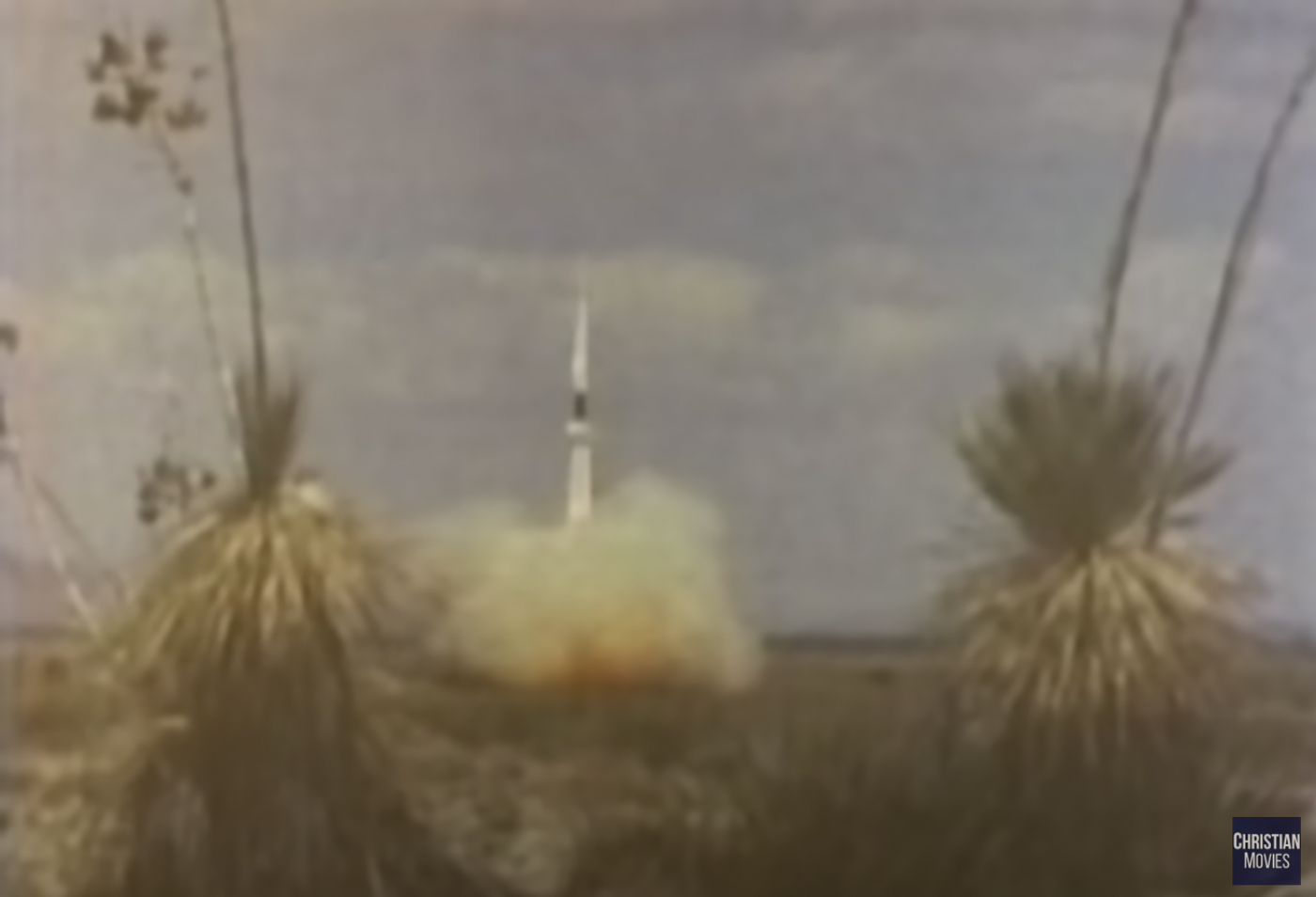
Shortly after being hailed as a hero for saving Israel, however, there’s another TV news report that Brother Christopher has been assassinated, in this series’ version of the Beast’s fatal head wound that miraculously heals. This news has resulted in a level of grief from the world’s population that the anchor compares to the death of JFK.
But, of course, Brother Christopher himself is soon on the radio, saying not to worry, he has come back to life. Turner has previously explained that this will result in Jews treating Brother Christopher as the messiah on top of everything else, seemingly setting us up for him to soon enter the Temple of Jerusalem and demand worship.
That night, Kathy begins to confess she has feelings for David, but he cuts her off and says she really needs a relationship with Jesus. And she can have it, because somehow—despite having been married to a believer who we saw in the grocery store threaten his wife and a cashier with the events of the tribulation—she didn’t truly hear and understand God’s plan. So she didn’t make an informed choice to reject Jesus before the rapture.
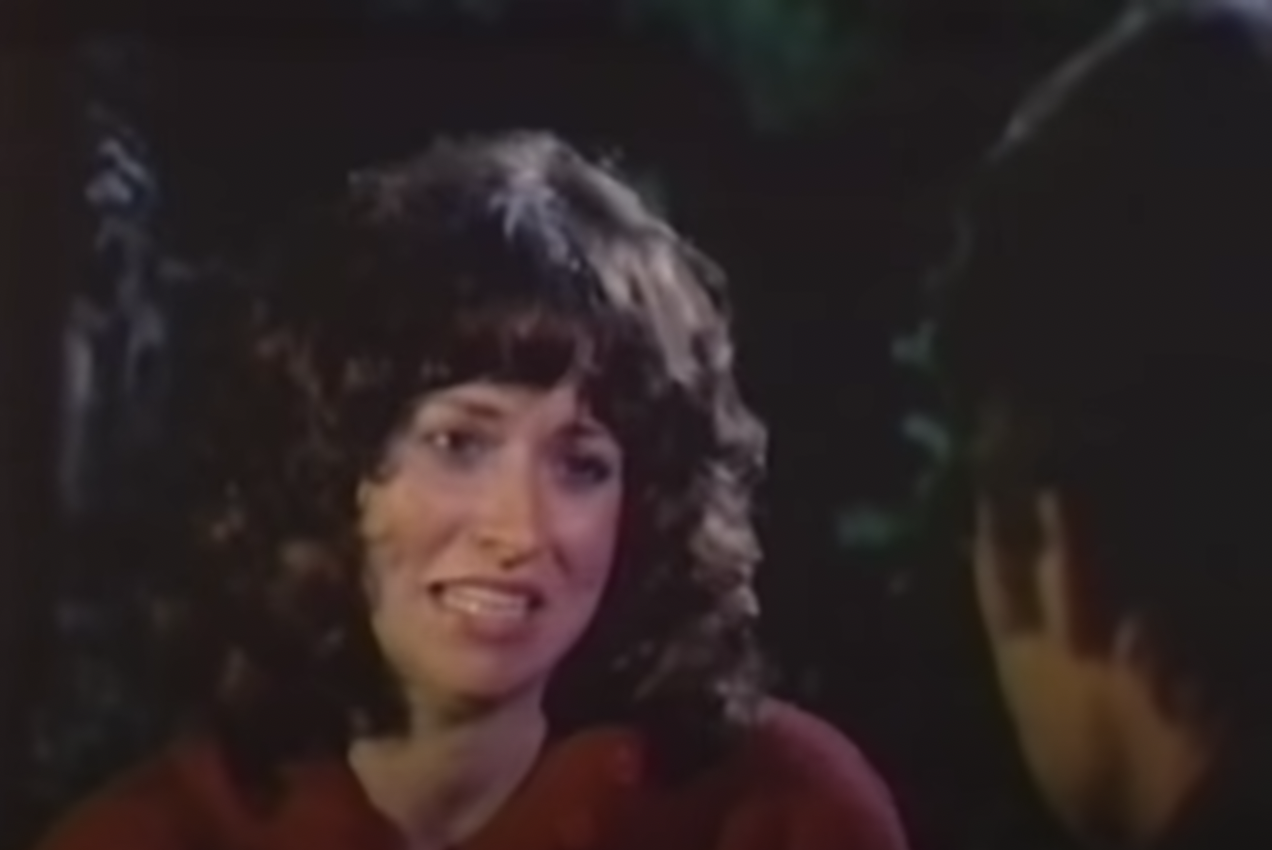
Of course, it goes without saying that there’s a lot of ambiguity about what “hear” and “understand” really mean. But in this case, David seems satisfied that Kathy didn’t know what she was missing then, so if she converted as soon as she learned the truth, that is, now, David says she could still be saved. But she says she needs more time to think about it.
I thought the series might be going in this direction earlier, since Distant Thunder makes such a big deal of showing that Patty and Reverend Turner both had the entirety of the dispensationalist view of the End Times explained to them several times before the rapture and still rejected it. But as I said before, the consequences of rejecting God’s plan is never discussed, and it seems like everyone who tried to convert to Patty during the tribulation truly thought she could convert any time and be saved.
Now that I look at it again, even the pamphlet that Patty reads in Distant Thunder prefaces the assurance that people who convert after the rapture will be saved, whether intended to be exclusive or not, with “Perhaps you did not hear or understand the Gospel before the rapture”:
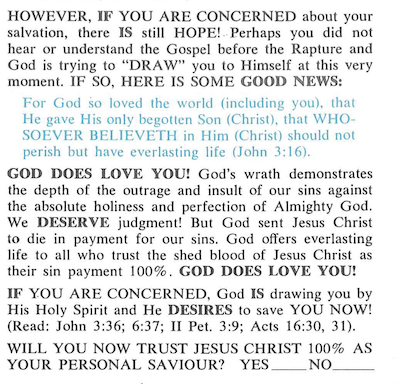
So I’m not sure why this is only coming up now. Was Patty always supposed to be destined for the flames no matter what the whole time and just nobody else realized it? That feels unlikely. Incorrect views are clearly signalled as such, and any character lecturing another at length on dispensationalist beliefs is almost certainly supposed to represent the views of the filmmakers. I suppose their own views just evolved halfway through?
Soon we hear another news report on the radio, this time explaining that Brother Christopher has eliminated the two dangerous religious fanatics in Jerusalem who were converting Jews to preach the Gospel — the witnesses.
By this time, David and Kathy are confident enough in their artificial marks to try to buy groceries with them, but it doesn’t work, and they flee while the cashier is calling the authorities.
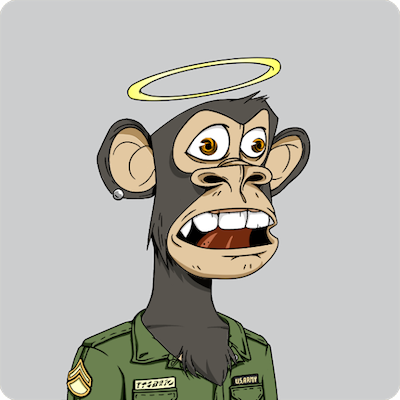
After another van chase, David is arrested but Kathy escapes. We hear on the radio during this scene that the witnesses have come back to life.
Back at Reverend Turner’s house without David, Kathy gets another lesson on Revelation. We get this great exchange about the army of horsemen who kill one-third of humanity during the events of the sixth trumpet:
Kathy: 200 million horses?
Turner: There were that many horses in China in the late 70s, Kathy. Anyway, the seventh trumpet…
Leaving aside the mansplaining, there were also only 11.5 million horses in China in 1978.
While David is in custody, Jerry, who it turns out is now a high-up intelligence agent for UNITE, visits him and seemingly convinces him to flip and spy for him. He doesn’t require him to get the mark, so he can keep his cover.
We see a newspaper headline saying the World Church has dissolved, so we know what’s coming next. David is assigned with some other UNITE agents to provide security at an important speech, where it’s going to happen.
In front of a huge crowd—who, ironically, were actually in Iowa to see the Pope—a man who is likely the False Prophet blames the disasters brought by the judgements on Jesus and God. Which, just as when Patty said the same thing, is totally valid: the Beast may have executed a bunch of people, which is obviously not okay either, but he didn’t open any of the seals. Anyway, just as expected, the False Prophet tells everyone to now follow Brother Christopher instead.
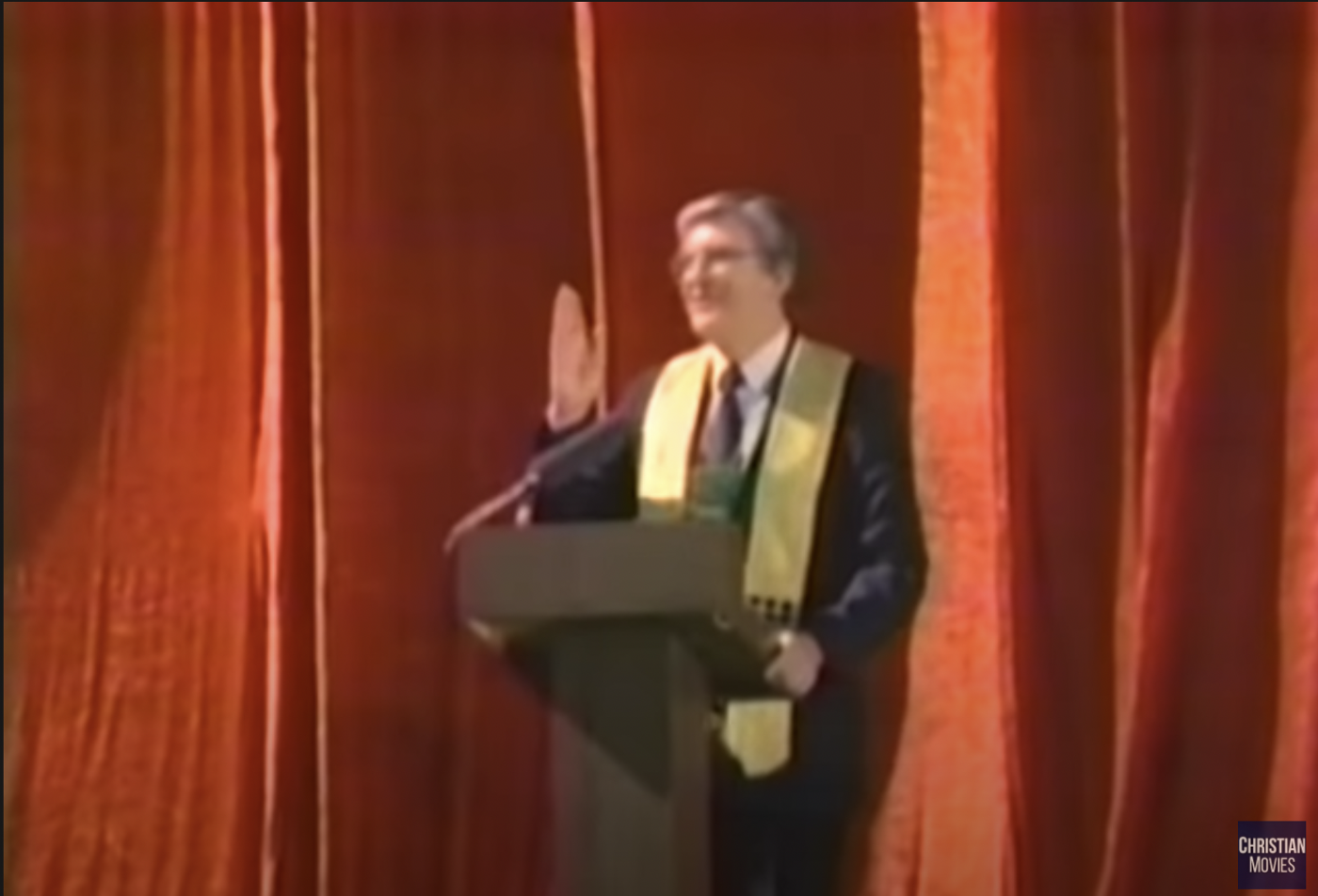
After the speech, David manages to escape from the other agents, even while pursued by a helicopter.
Funnily enough, even though there are an absurd number of helicopters in the next film (or at least the same couple of helicopters pretending to be different ones) the A Thief in the Night series doesn’t actually interpret the locusts as helicopters, which it turns out comes from Hal Lindsey.
So, a reminder: we’re now at the halfway mark in the tribulation, around 3.5 years, and worship of the Beast is beginning:
Tribulation timeline
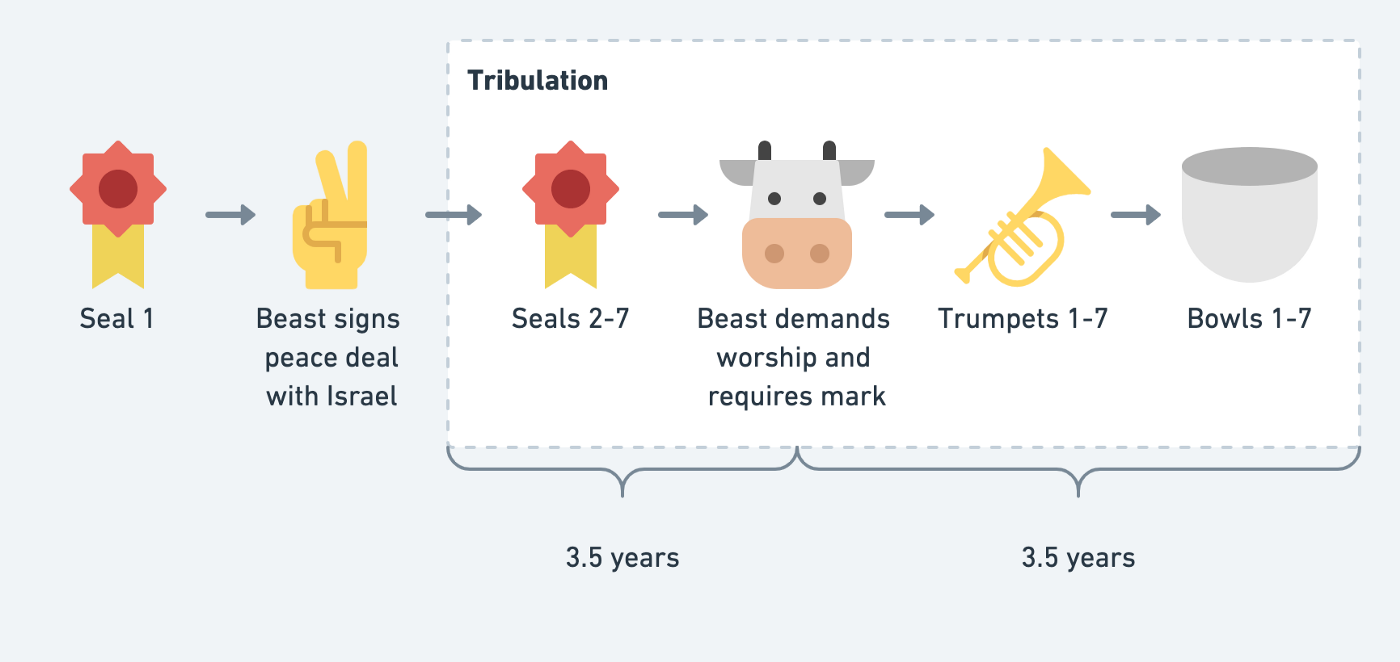
Meanwhile, back to Turner mansplaining things to Kathy. He claims that “the computer” is already the new golden calf—which appears in Exodus and describes a false idol the Israelites started worshiping because they thought Moses was away for too long, and for which indiscretion God struck them with a plague. Turner’s reasoning is that the computer has been “the most innovative and time-saving device known to man.”
But now, he says,“a computer that speaks and convinces people that it thinks is in the Temple of Jerusalem and hundreds of millions of people will worship that inanimate object.” Which goes beyond being the golden calf to being the titular image of the Beast.
Indeed, on TV we finally see Brother Christopher, atop a golden throne, likely in the Temple of Jerusalem. He says it has now been four years of hardships, but humanity has triumphed due to two things:
- The computer.
- The intervention of “His Satanic Majesty” (which I was surprised to learn is 100% a Rolling Stones reference, rather than both of them drawing on a common source. So I wonder if someone other than Doughten and Thompson snuck it in there without them realizing).
Giving a shout out to Satan is pretty bold, but I guess if you have that level of influence over people, why not just tell it like it is? Brother Christopher, like the False Prophet, also points out God’s role in the disasters brought by the judgments.
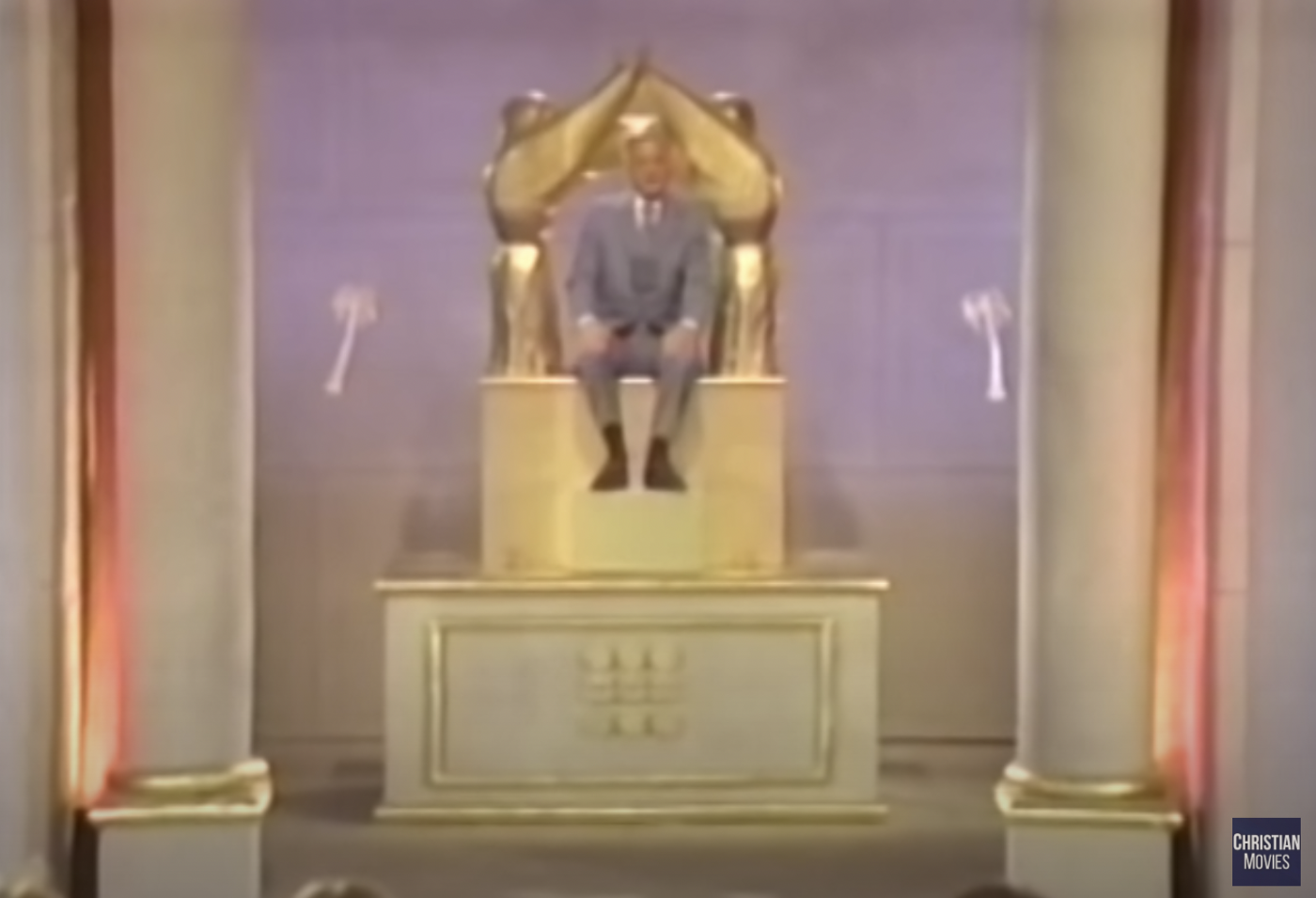
While Kathy and Billy and Reverend Turner are in a cave with some other Christians, fire starts falling from the sky outside and leaves the landscape totally denuded. (The filmmakers took the landscape footage from around Mt. St. Helens after the 1980 eruption, which must have happened while the film was in production.)
So we’re now onto the film’s version of the first trumpet. David somehow both avoids getting burned up during his journey back and manages to find everyone in the cave.
I guess now is a good opportunity to put in my newest diagram, to keep the trumpets straight:
The seven trumpets

Next we see the stream where the characters get their fresh water turn to blood, which seems like it might be combining the next two trumpets: the second trumpet includes a burning mountain that falls into the ocean and turns one third of the sea into blood, and the third trumpet includes a falling star that poisons rivers and springs. Then, in the next scene, we get to the fourth trumpet as it gets dark early and Billy wonders if he has to go to bed.
At this point, Kathy looks again at the cover of her book Computer Prophecy, and suddenly realizes the mark system is based on the bar code system.
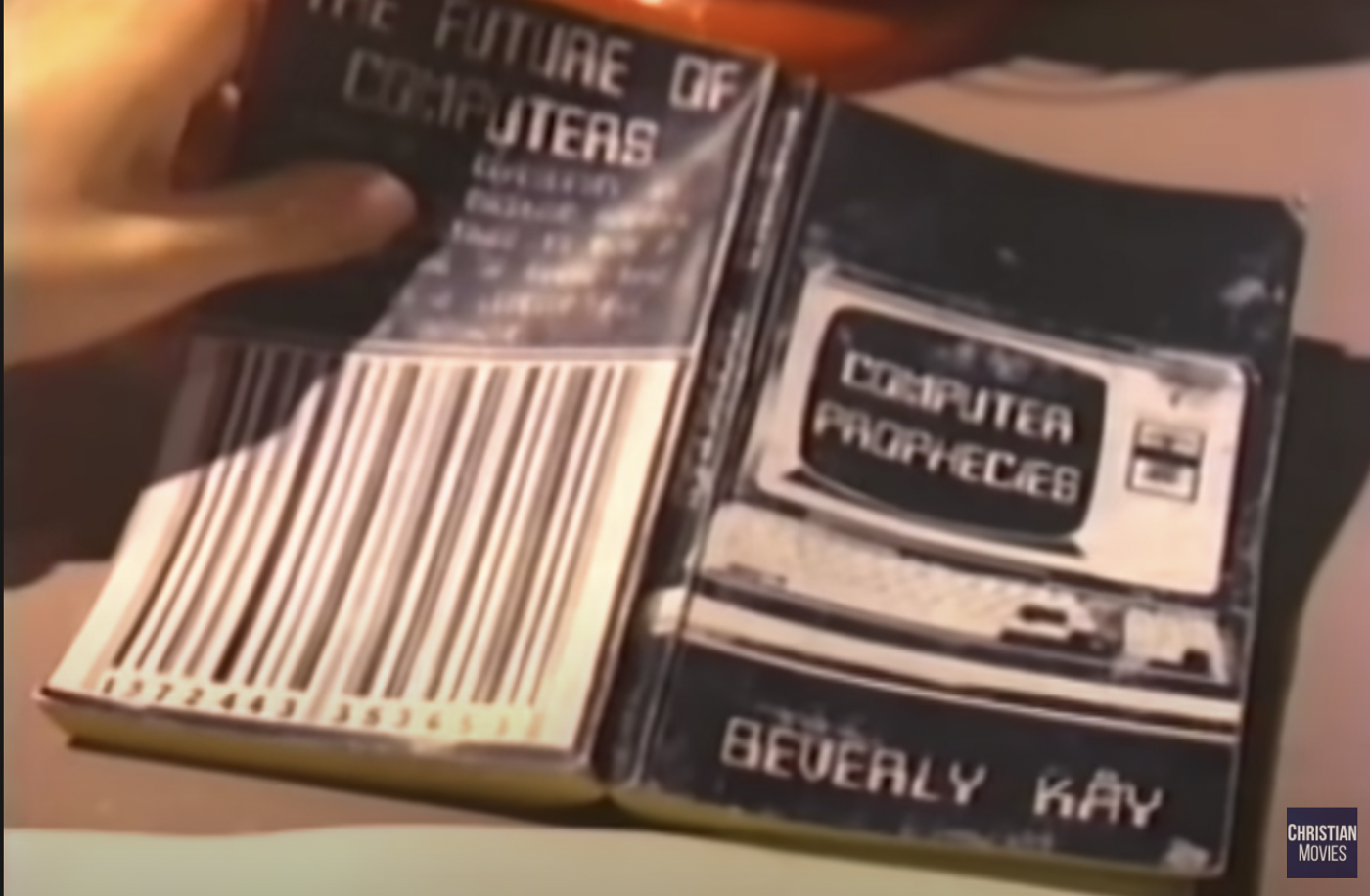
Then Leslie shows up again; she didn’t die after all and she was found and taken in by an elderly Christian couple while she recovered. Because of her injuries she needs to use a wheelchair now, but the way it is handled would still be considered pretty respectful and positive representation in 2022, which was also surprising. It felt a little like the Temple location choice from Left Behind.
And now Leslie and David confess their love for each other, not Jesus, or rather, in addition to Jesus, and even make out and there’s lip-to-lip contact with no cutting away to footage of elderly women. It was a different era, I guess.
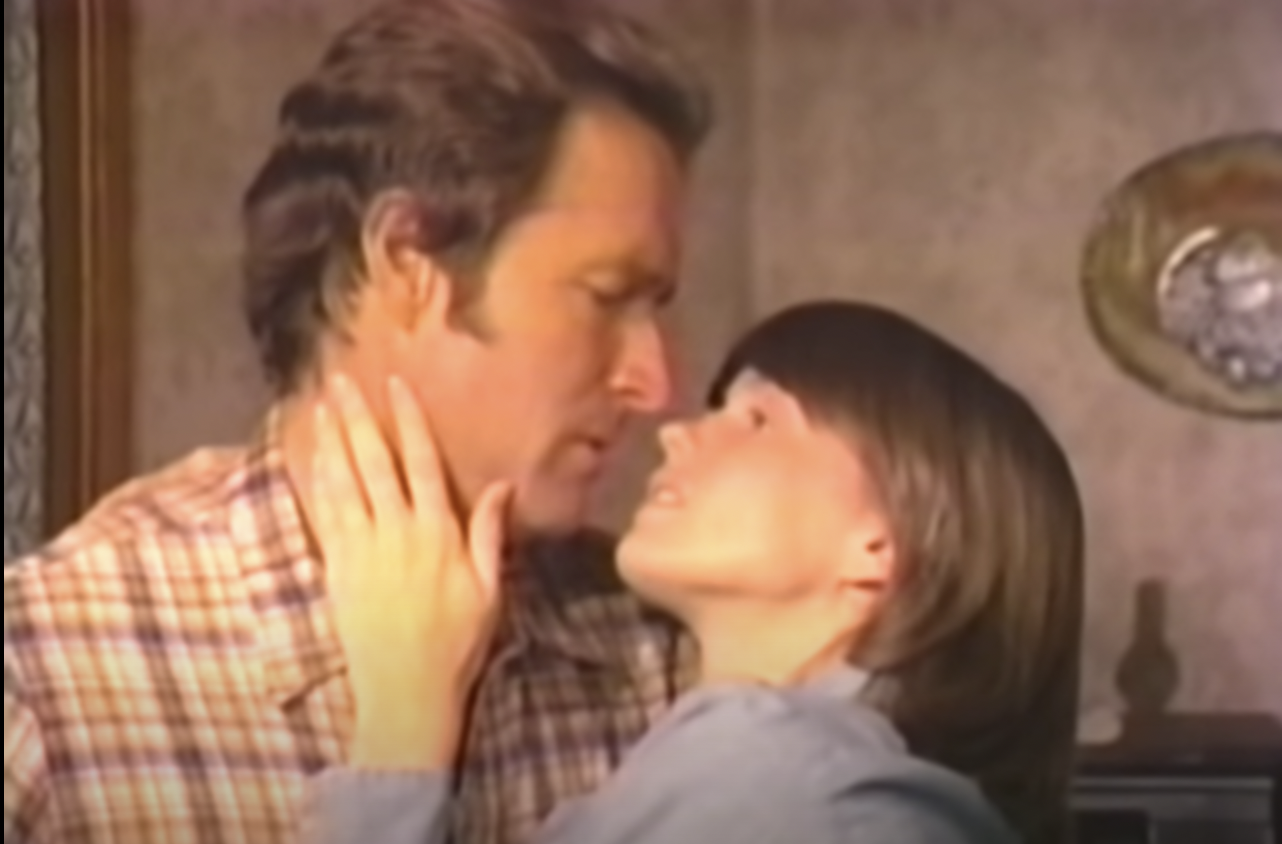
But she and David are tricked and captured by Sandy, Wenda’s sister who betrayed Patty from the previous film, and who’s now, like seemingly almost everyone, a UNITE agent.
Before Kathy can do anything with her new knowledge about the bar code system, Diane shows up and holds Kathy at gunpoint. Billy is able to run off but he gets captured. Diane reveals to Kathy that she’s also, guess what, a UNITE agent.
“My grinning face is the last thing you’ll ever see before your head falls in a basket,” she says.
But then they hear a loud buzzing and Diane is attacked by what is supposed to be the scorpion stinger of one of the locusts from bowl five). All you see, however, is what looks like a big grey leg coming in through the doorway.
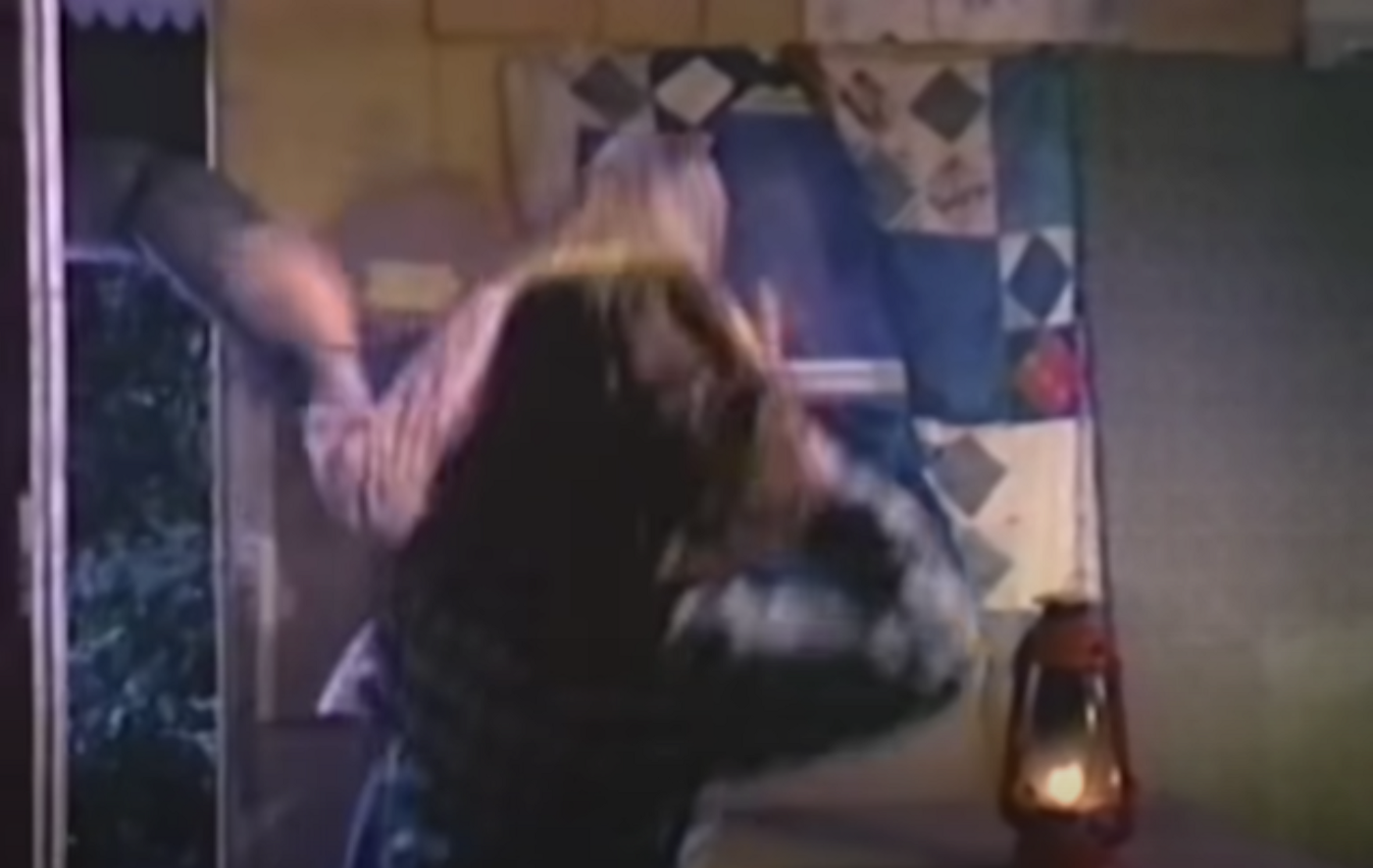
After Kathy runs off, we see her get attacked by the shadow of the same prop as well. It seems to me that in Revelation the only people who the locusts leave alone are the 144,000 Jews who got the seal of God on their foreheads, but even if they also don’t sting other believers, Kathy hasn’t converted.
The very-useful-this-film Reverend Turner had confirmed earlier that the sting isn’t supposed to cause death, just five months of agony, but we don’t see Diane or Kathy again.
Then there’s a nuclear explosion blended with footage of the legs of horses running. Is it Russia going for round two? Is it 200 million horsemen (or 11?)? Is it both? Either way, seems like trumpet six.
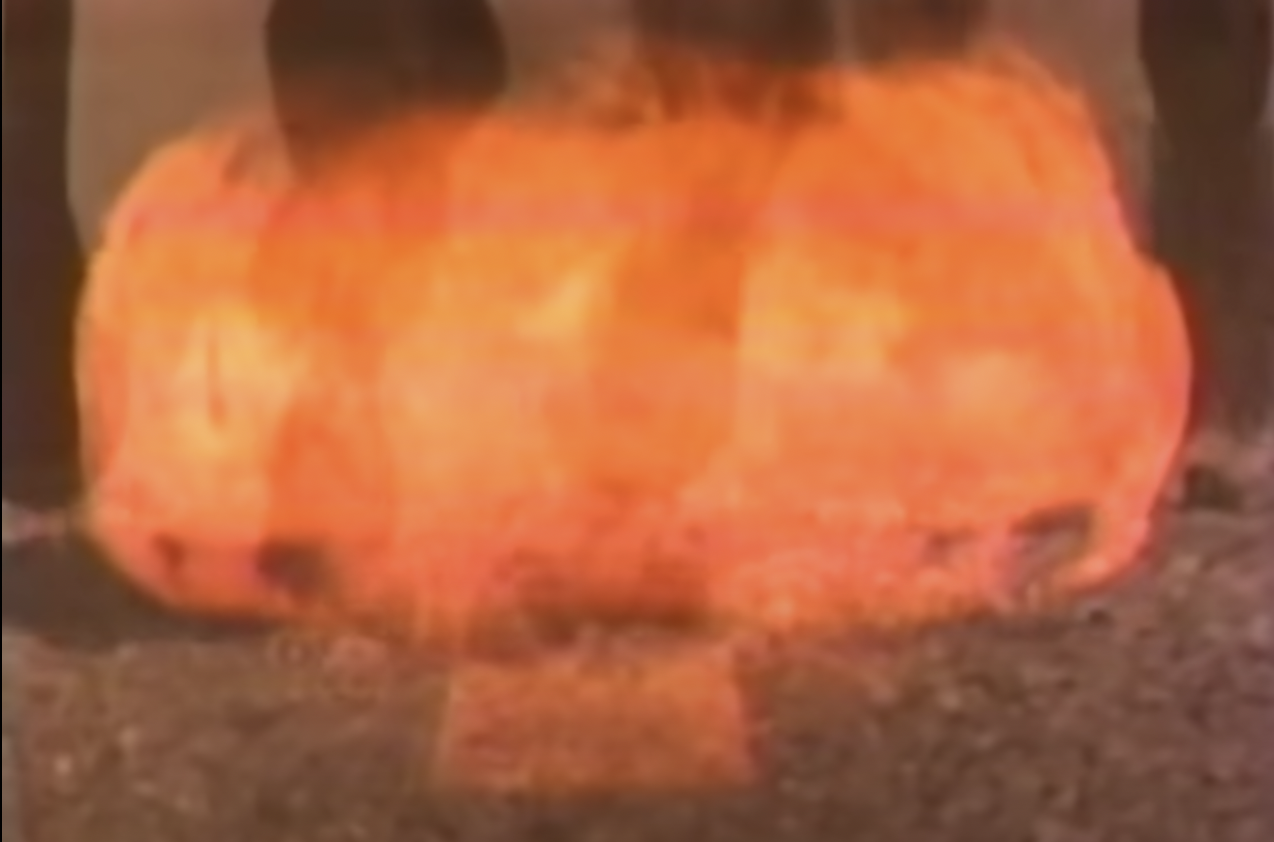
We also see Turner twitching on the ground outside with a bloodstain on his shoulder but it’s unclear whether he was stung or shot or what.
Meanwhile, in prison, Leslie converts Billy. Although she’s much nicer than Buck and doesn’t lean on the hellfire, this is way worse than Left Behind’s conversion of Chris.
Billy is literally three years old and even if it’s not intended to, the dialogue clearly gives away that he doesn’t understand what Leslie is saying, even if he’s supposed to have reached the age of accountability.
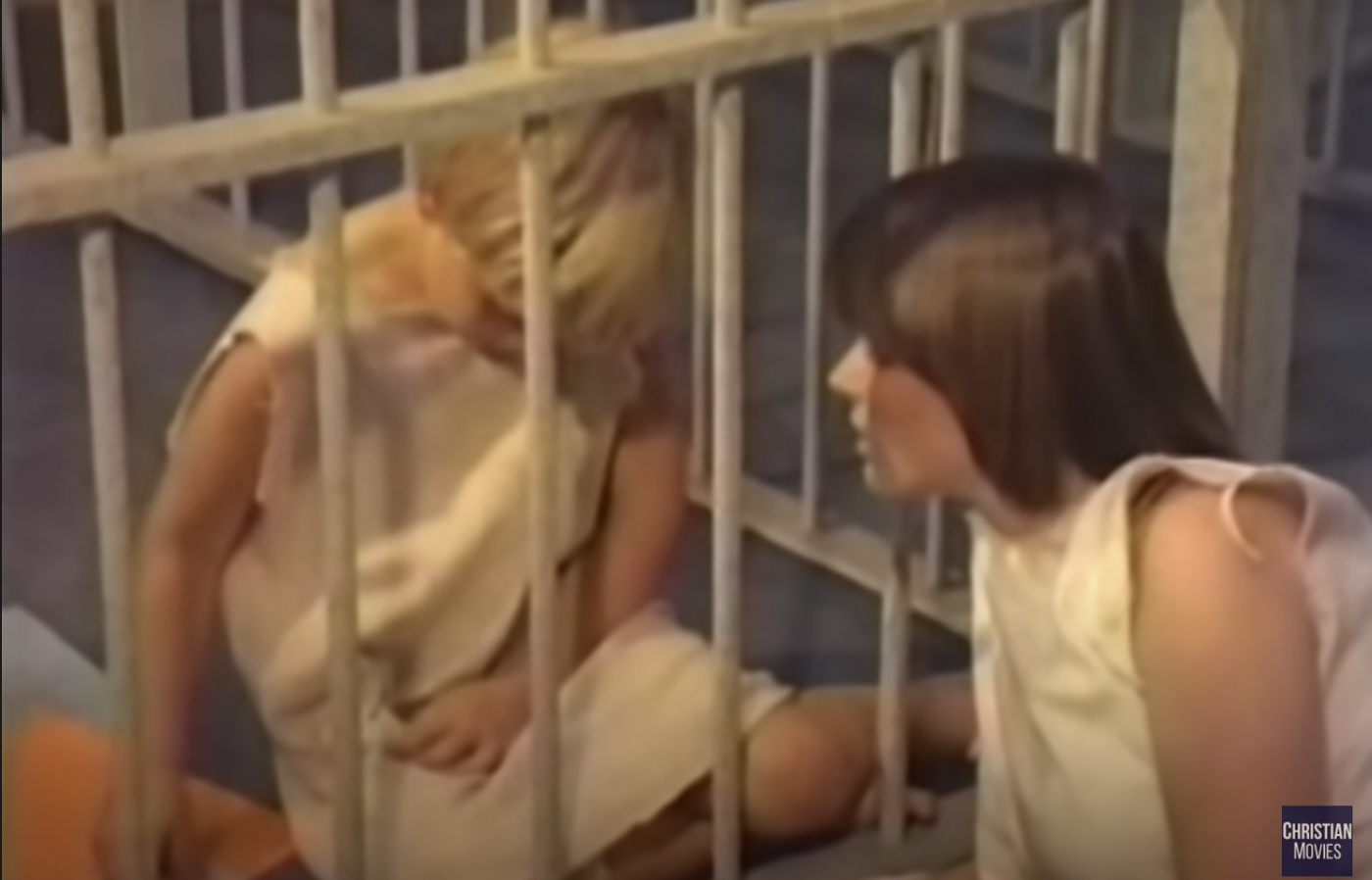
This is how that scene ends:
LESLIE: Billy, have you ever sinned?
BILLY: I guess so, I’m naughty sometimes.
LESLIE: Would you like to receive Jesus into your heart now and have your sins forgiven so that you can go to Heaven?
BILLY (excited): With you?
LESLIE: That’s right.
BILLY (super stoked): Yeah!
The guards order David to convince Billy to take the mark, but instead David tells Billy to close his eyes and put his faith in God when it’s his turn to be executed. Again, he is three years old. Leslie and Billy are then taken away to be beheaded. The film ends with guards bringing David up to the bloody guillotine too.
All right, speaking of suddenly cutting things off, you’ll have to find out what happens to David in the final film, The Prodigal Planet, in Part VI. And then, as teased over and over again like a glam rocker’s hair, in Part VII I will get to the most exciting bit, for me at least: how and why dispensationalists see signs that the End Times are coming in contemporary events, and what the real-world consequences are (and could be) of influential people and communities who share these beliefs seeing the End Times as a good thing.
I’ll give away one fact now in case you could use some motivation to make it through another whole post about the adventures of David and his friends before I get there: a lot of dispensationalists were super stoked when nuclear weapons were invented. But I’ll let you think about why exactly until Part VII comes out.
For music time, I figured that since we didn’t get to see the burning mountain from the second trumpet, I’d share the next best thing: A 2012 song by the experimental/noise rock band Oneida called “A List of the Burning Mountains.”
Feel free to bail out here if you like, since there’s no more End Times–related content, but if you feel like sticking around a little longer, this video reminded me that I was curious why Oneida, who last put out an album four years ago but appears to still be active, hadn’t come under pressure to change their name to one that doesn’t belong to a North American Indigenous people. They’re one of my favourite bands but I don’t feel great about their calling themselves that.
I found this article from 2003 that at least provides the band’s justification for why they picked the name to begin with: the Oneida Nation was betrayed by the government after fighting on the revolutionary side in the American Revolution and relocated, and their name was co-opted over and over again, being used for a county, two towns, a lake, a Christian religious commune, and finally a NYSE-listed company that makes silver spoons.
I mean, it’s good that the band were drawing attention to the history of the exploitation of the Oneida Nation and their identity; they didn’t just think the name was cool or whatever.
But by this point in history I think most people of a moderately progressive bent understand that there are much better ways of accomplishing that than choosing to also co-opt their identity for your band. And on that note, there’s also the painfully contemporary problem that doing so means you take over all the top search results for Oneida push down pages related to the Indigenous Oneida Band.
So, come on, Oneida. Time for a change. If Viet Cong eventually understood people’s concerns and changed their name, you can too. And I’m sure in a band where all the members have given themselves names this cool, Oneida can come up with a way better name than Viet Cong did when they switched to Preoccupations:
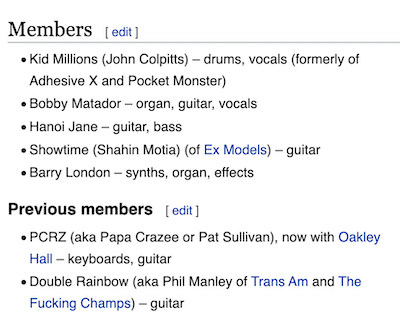
All right, unexpected journey into music journalism over. See you next time for the final film in the series and some thoughts on all four.
Subscribe to The Golden Age of Apocalypse
Get the latest posts delivered right to your inbox
